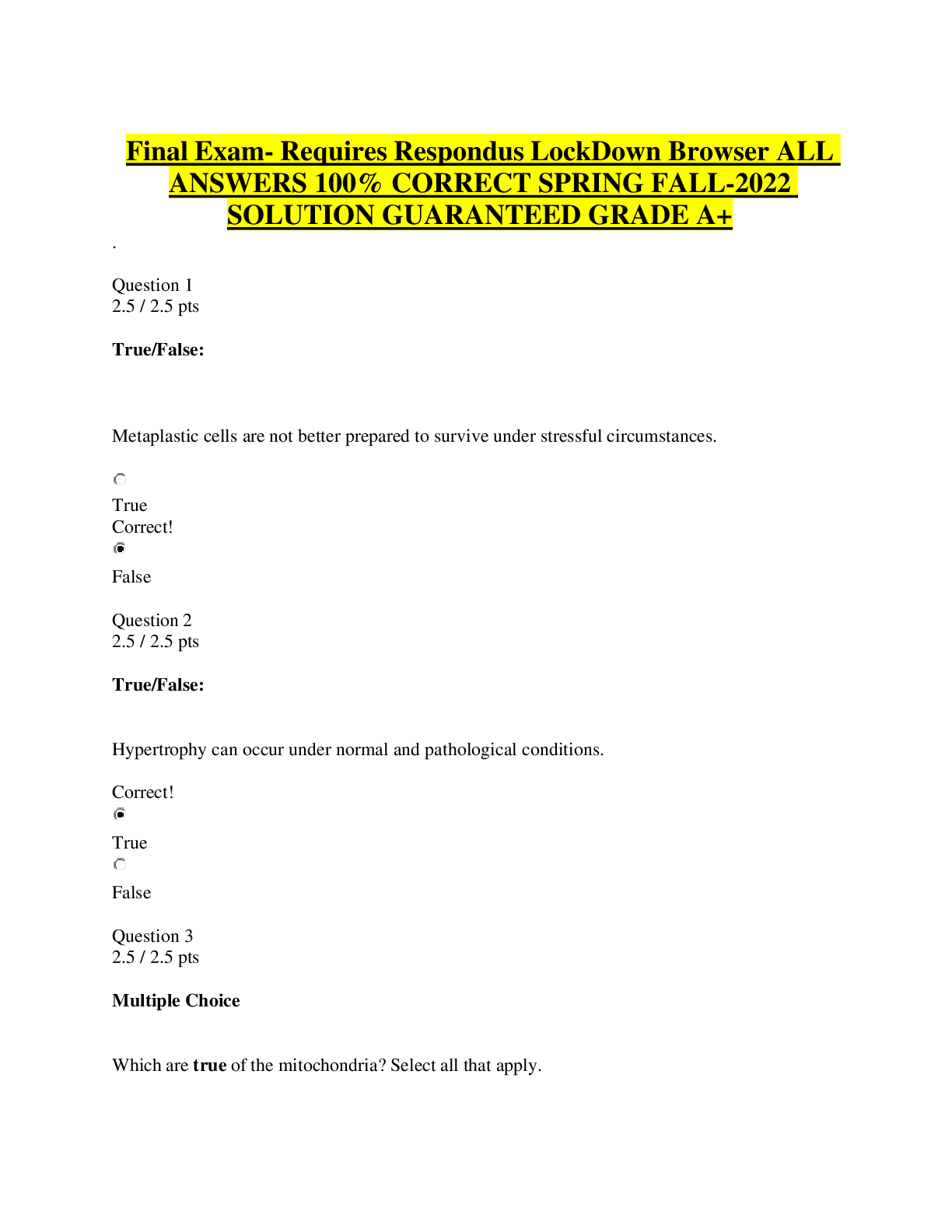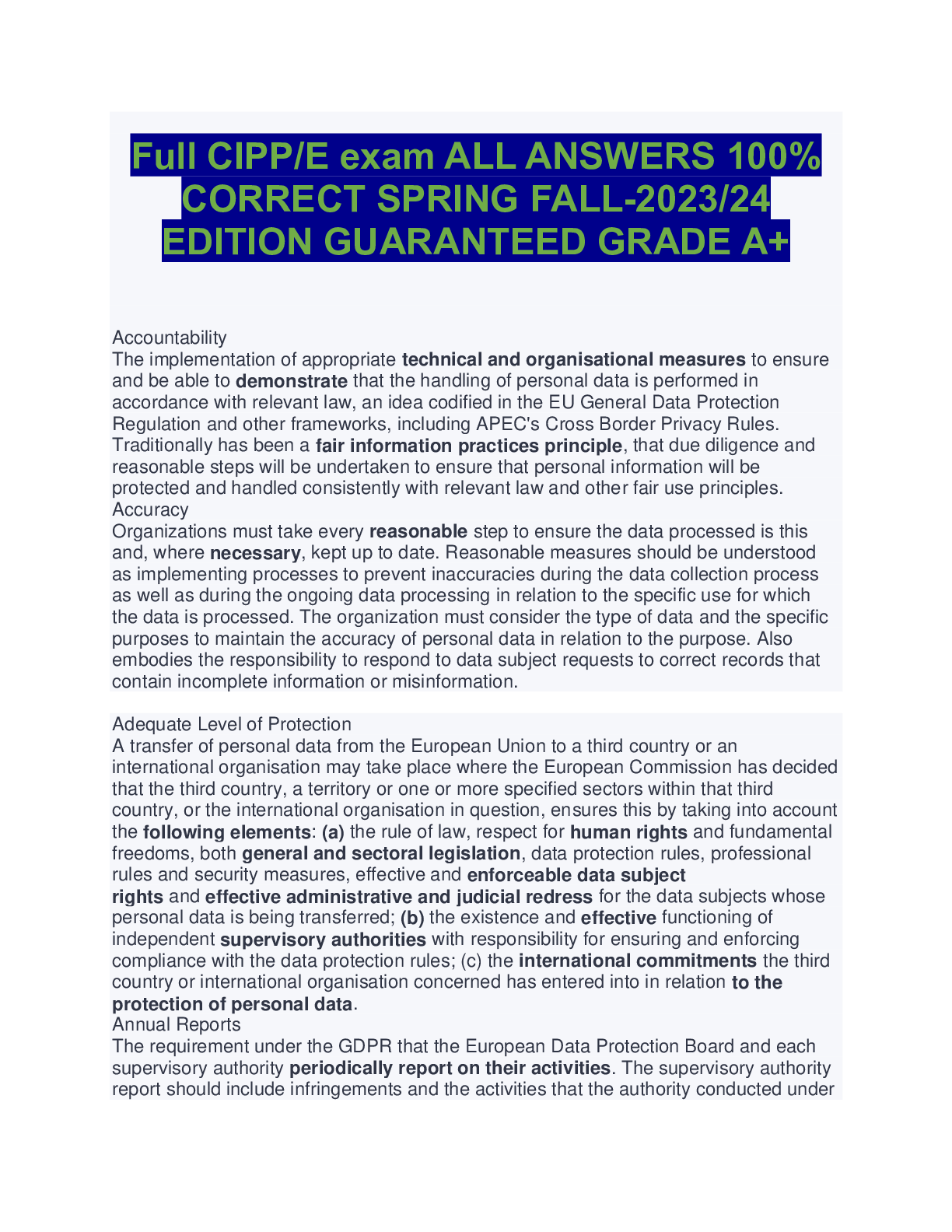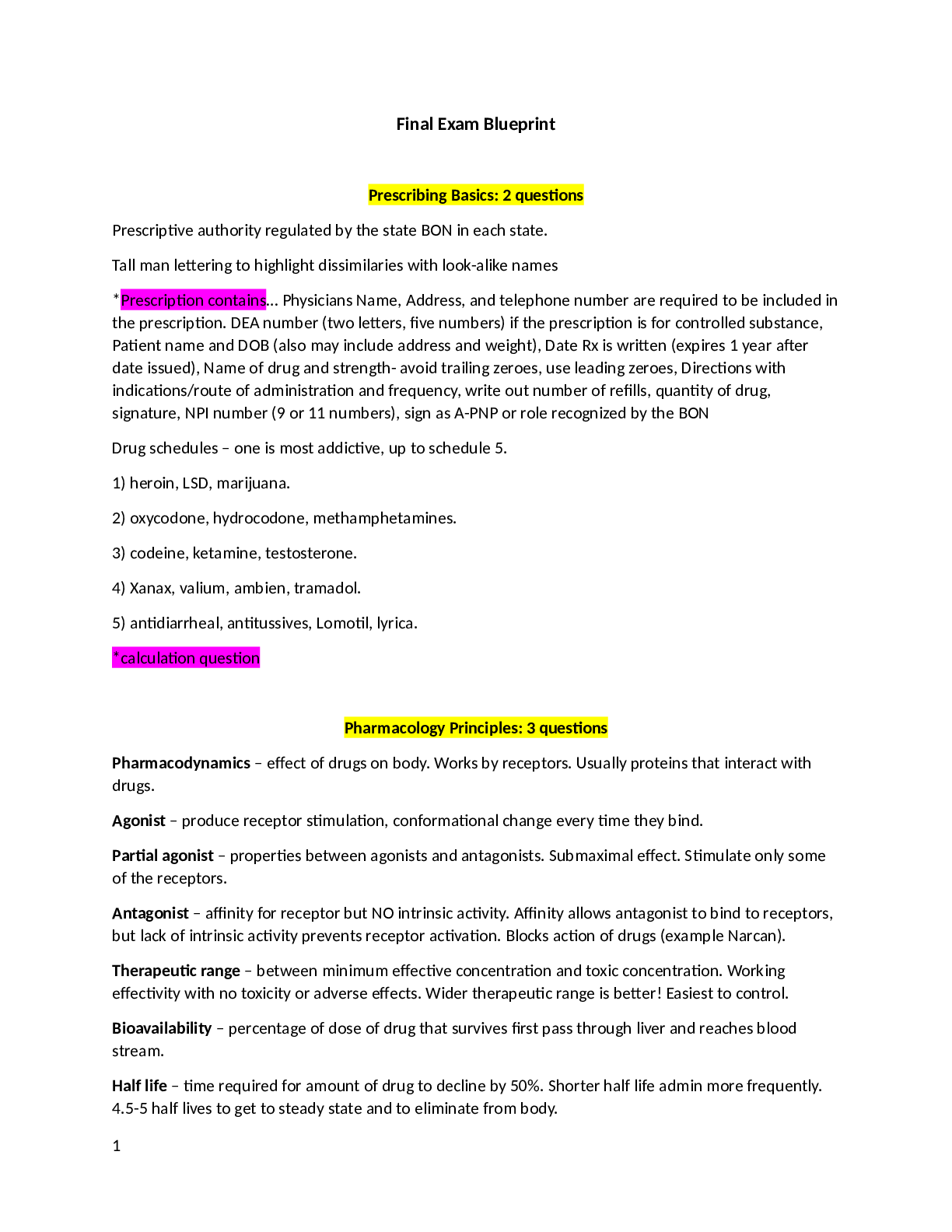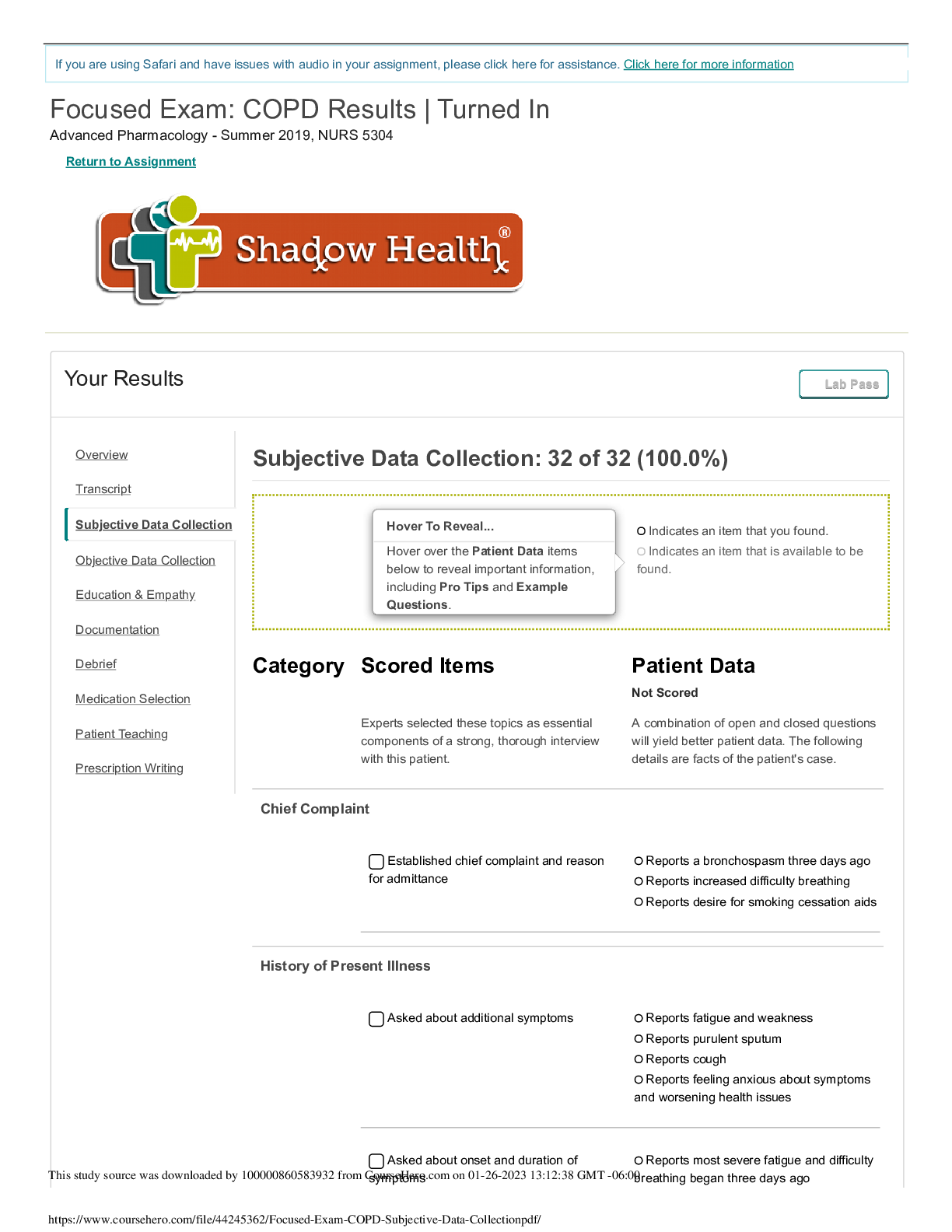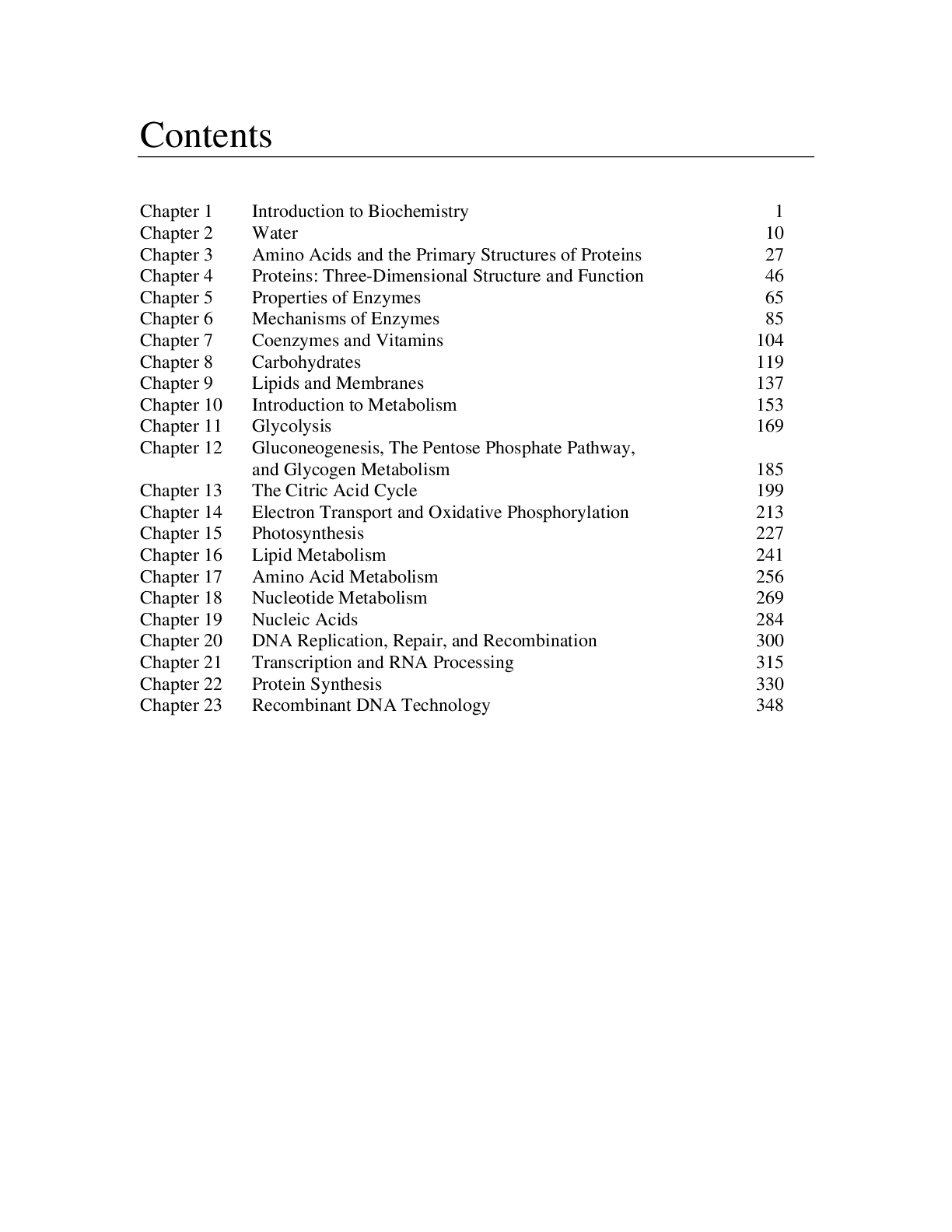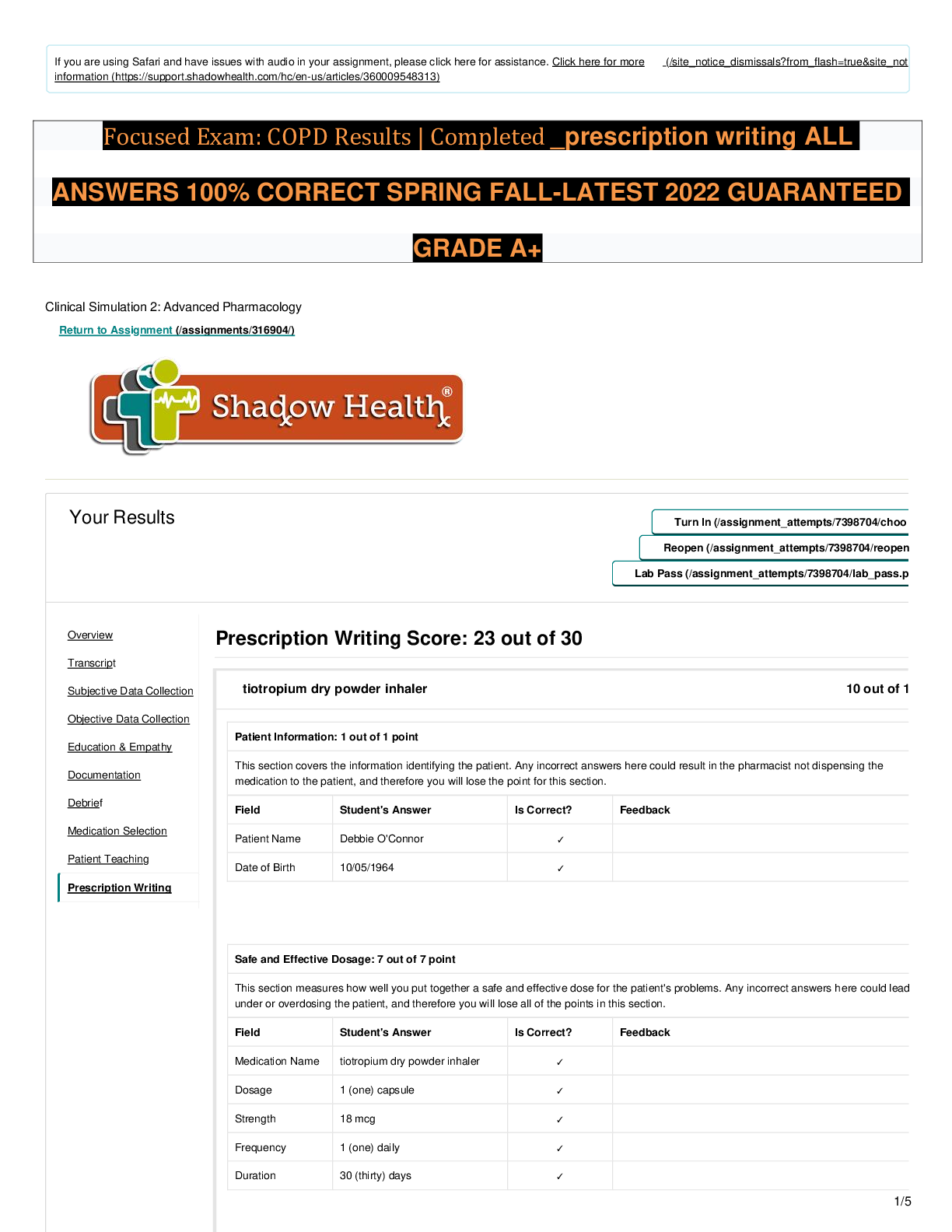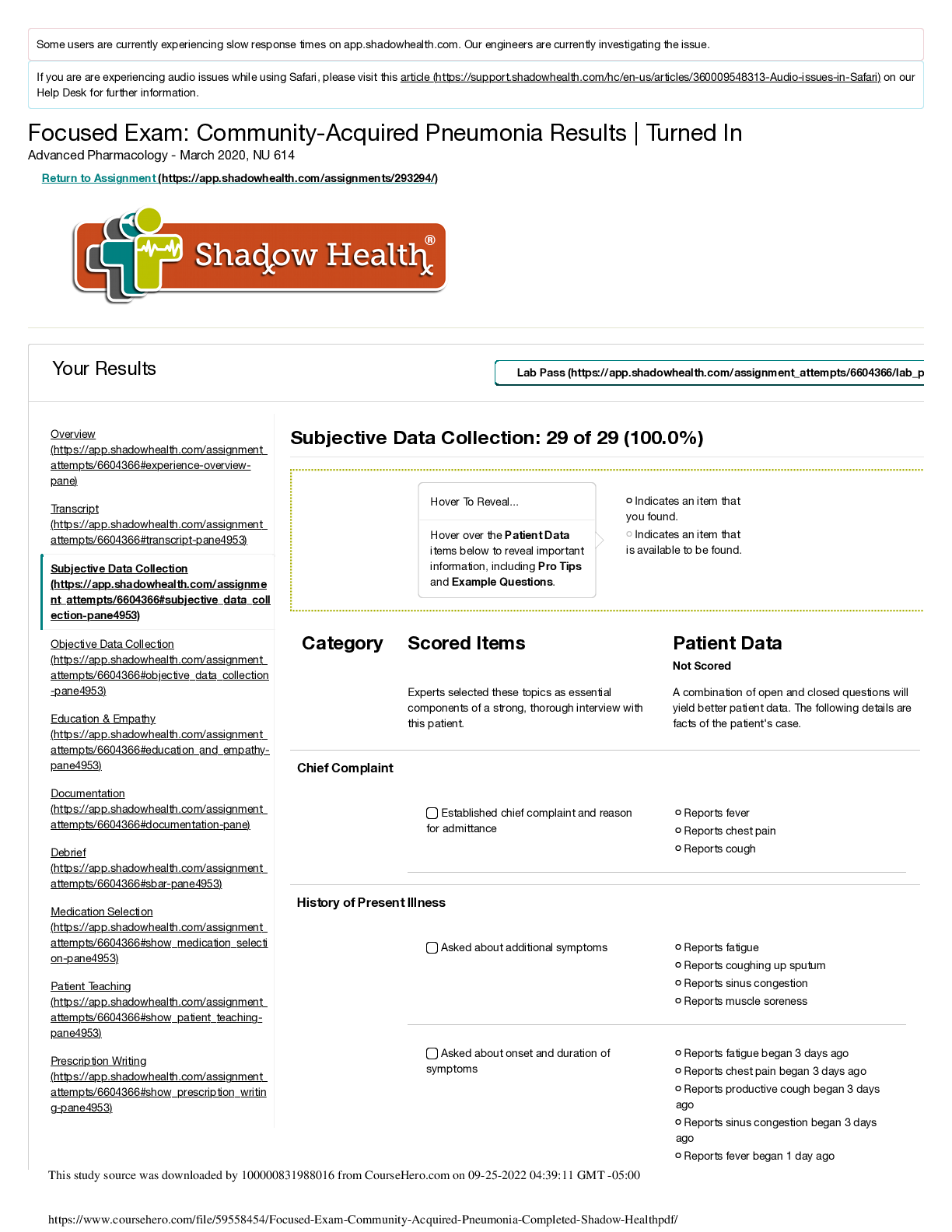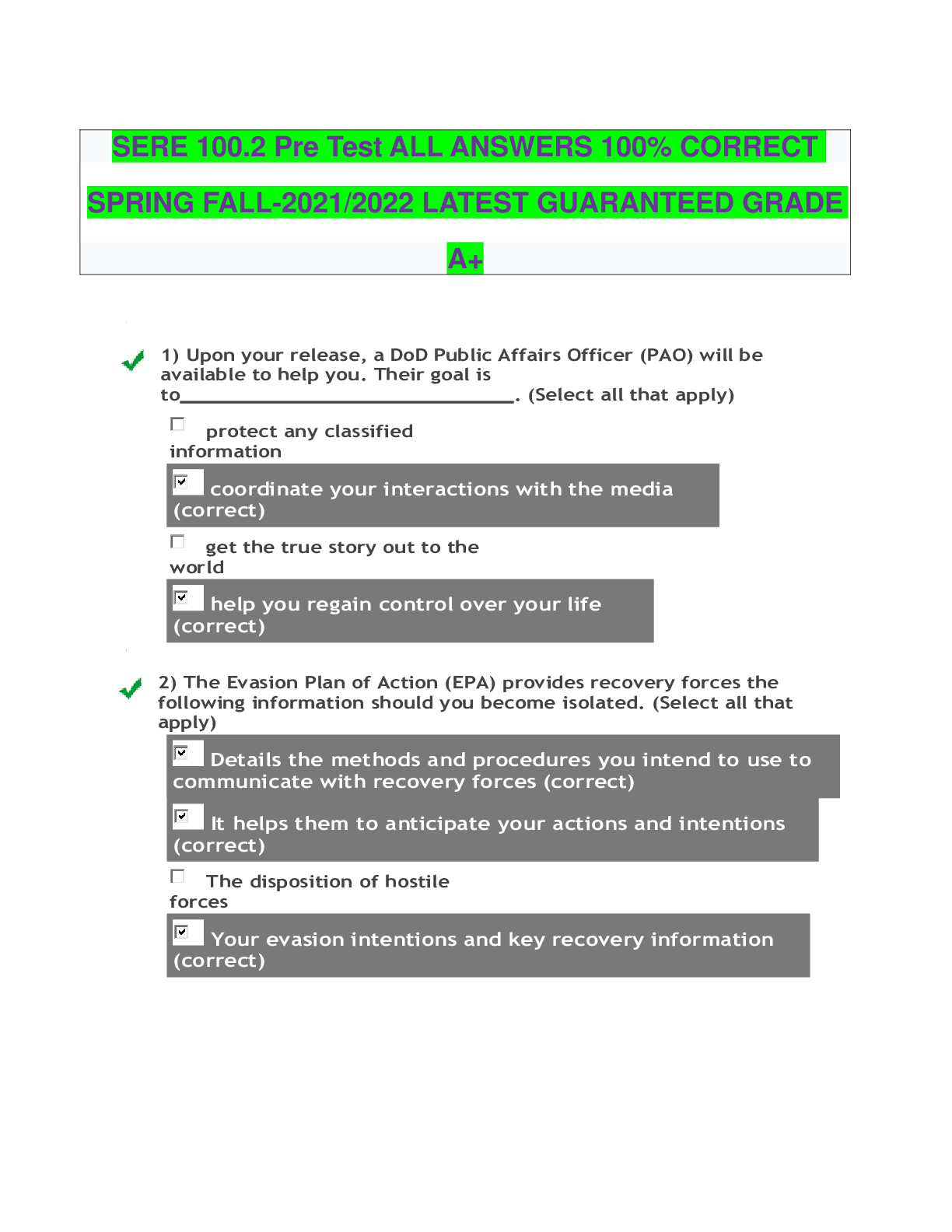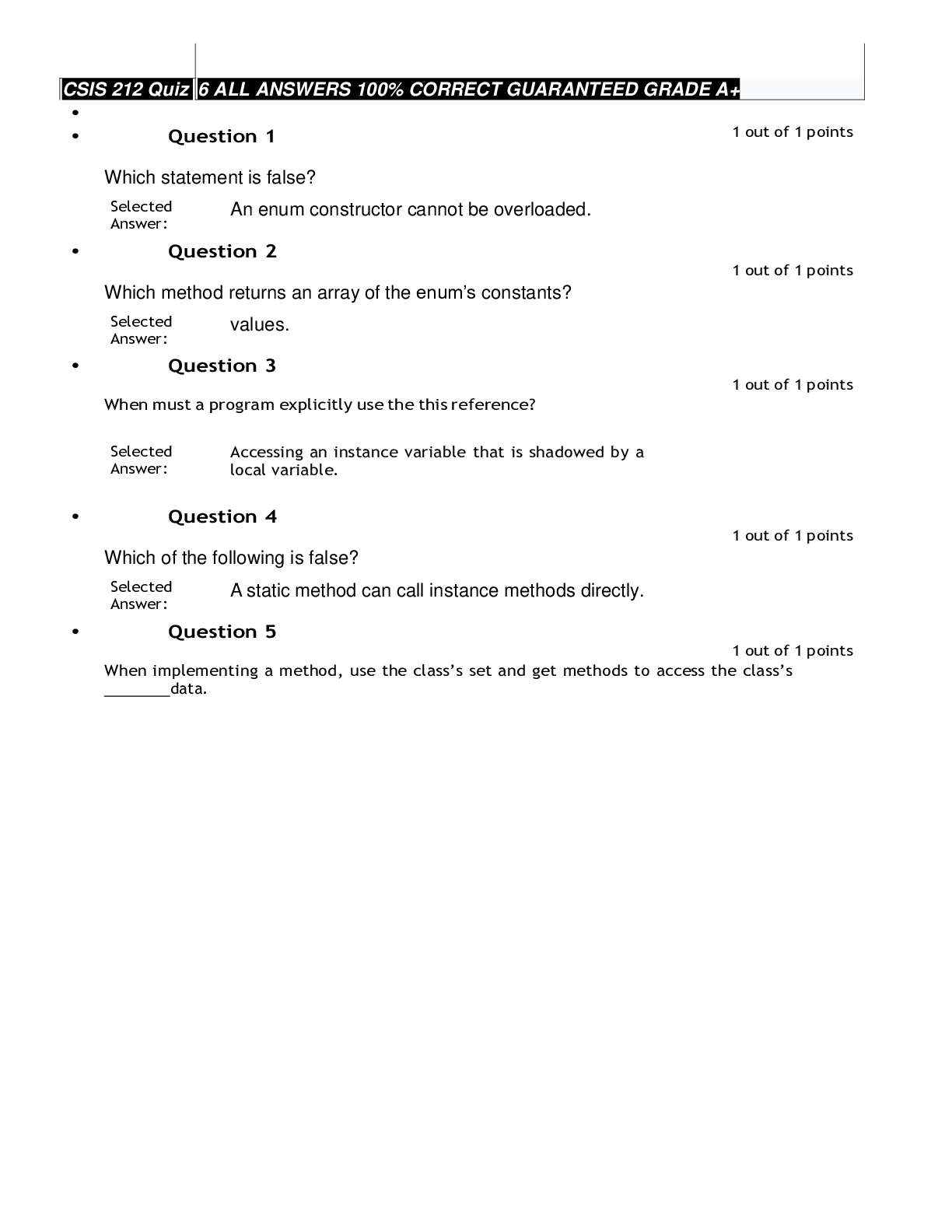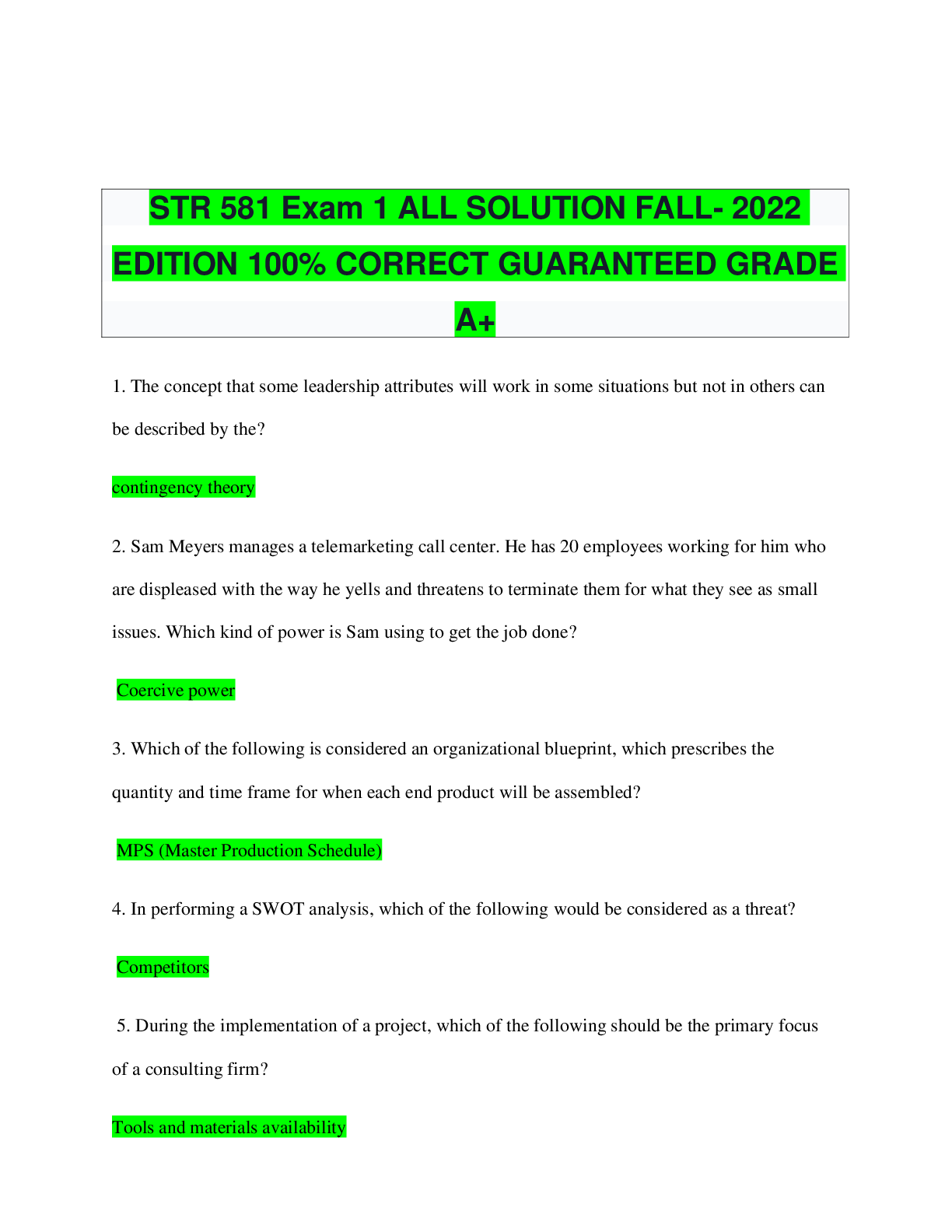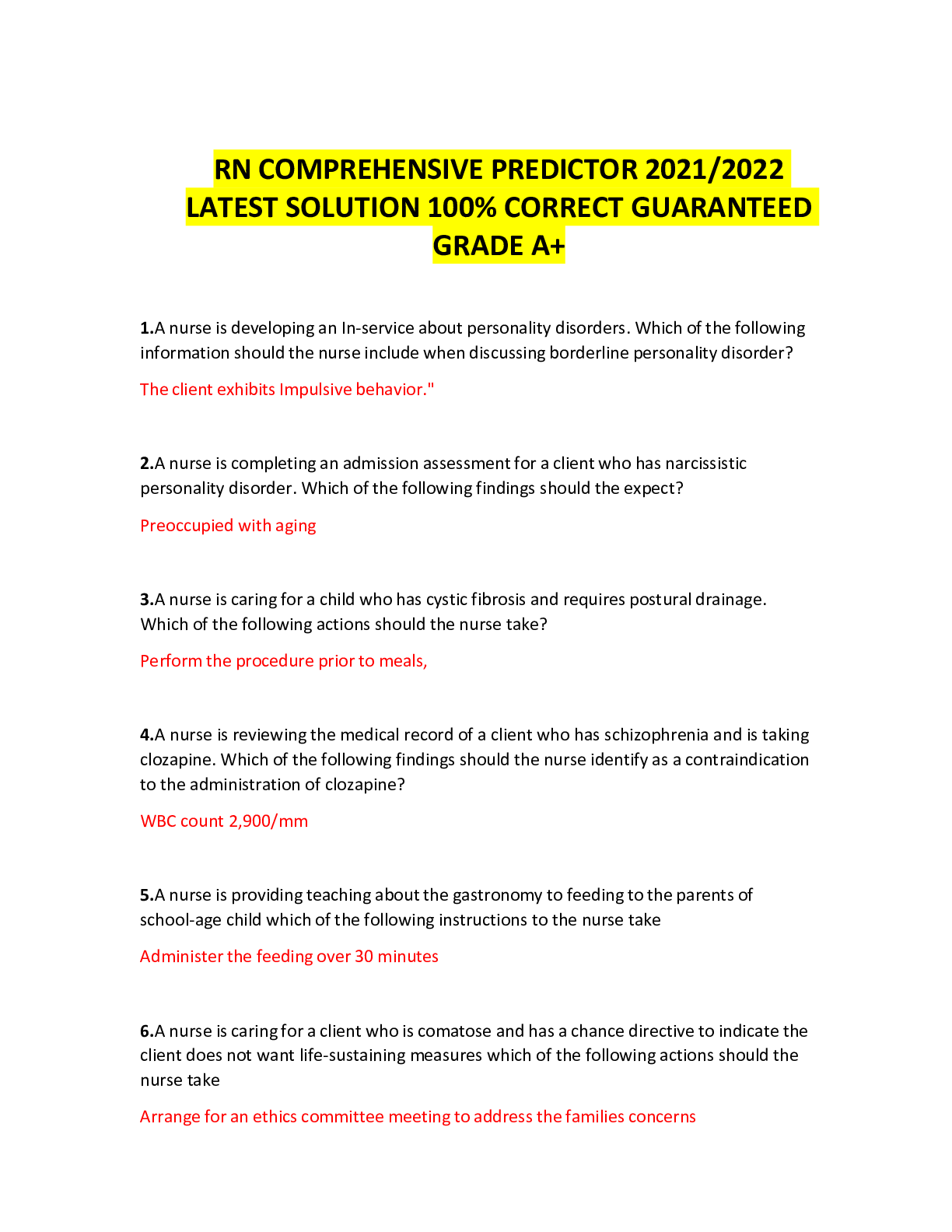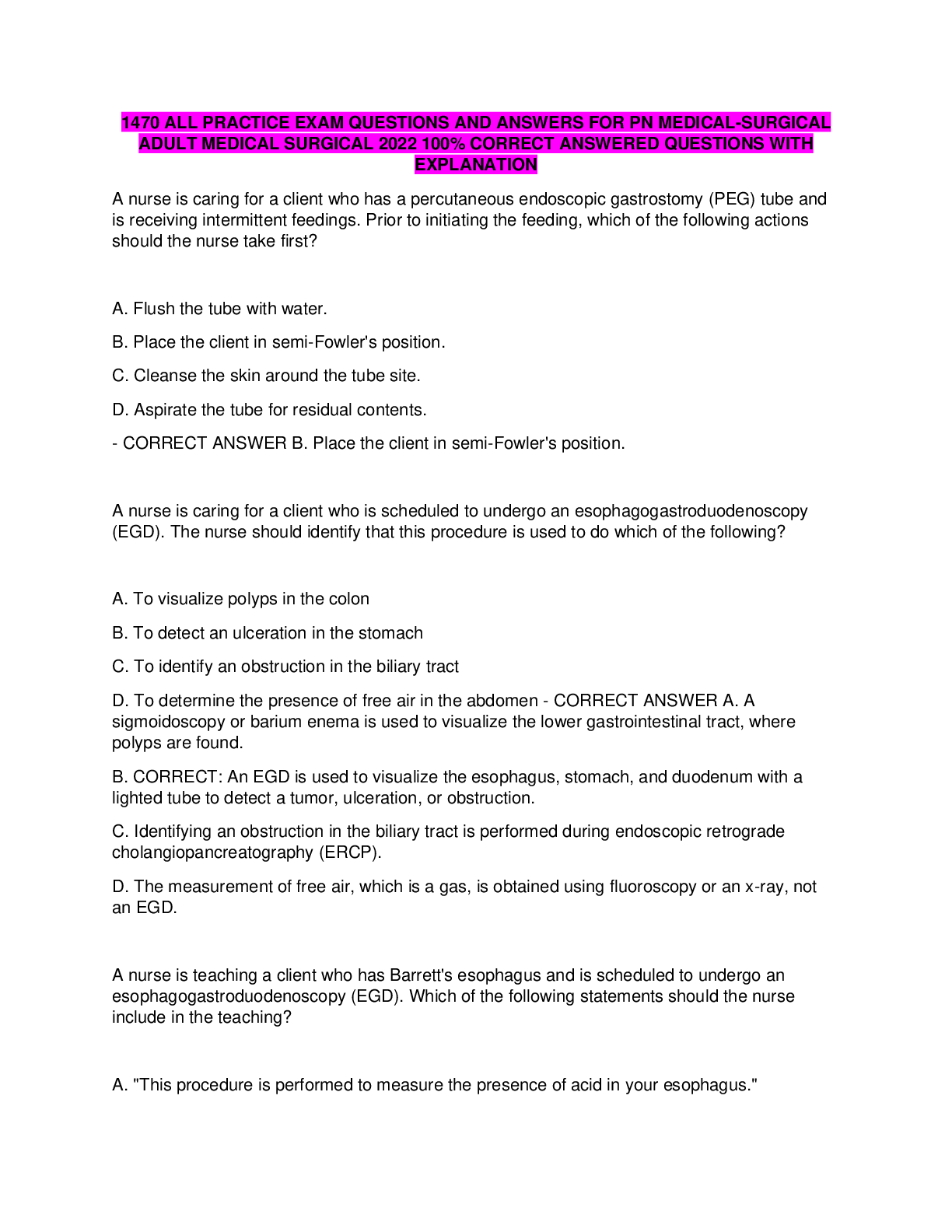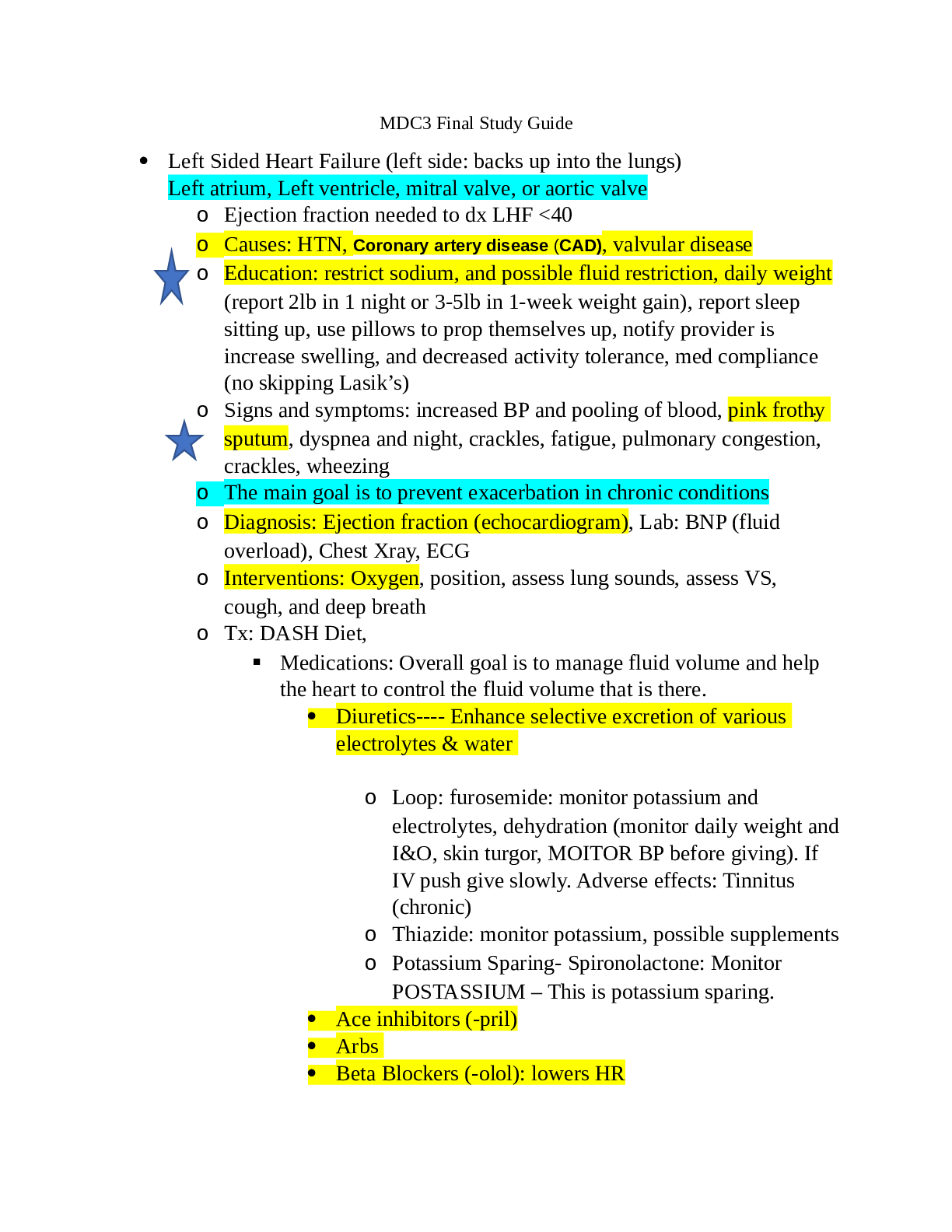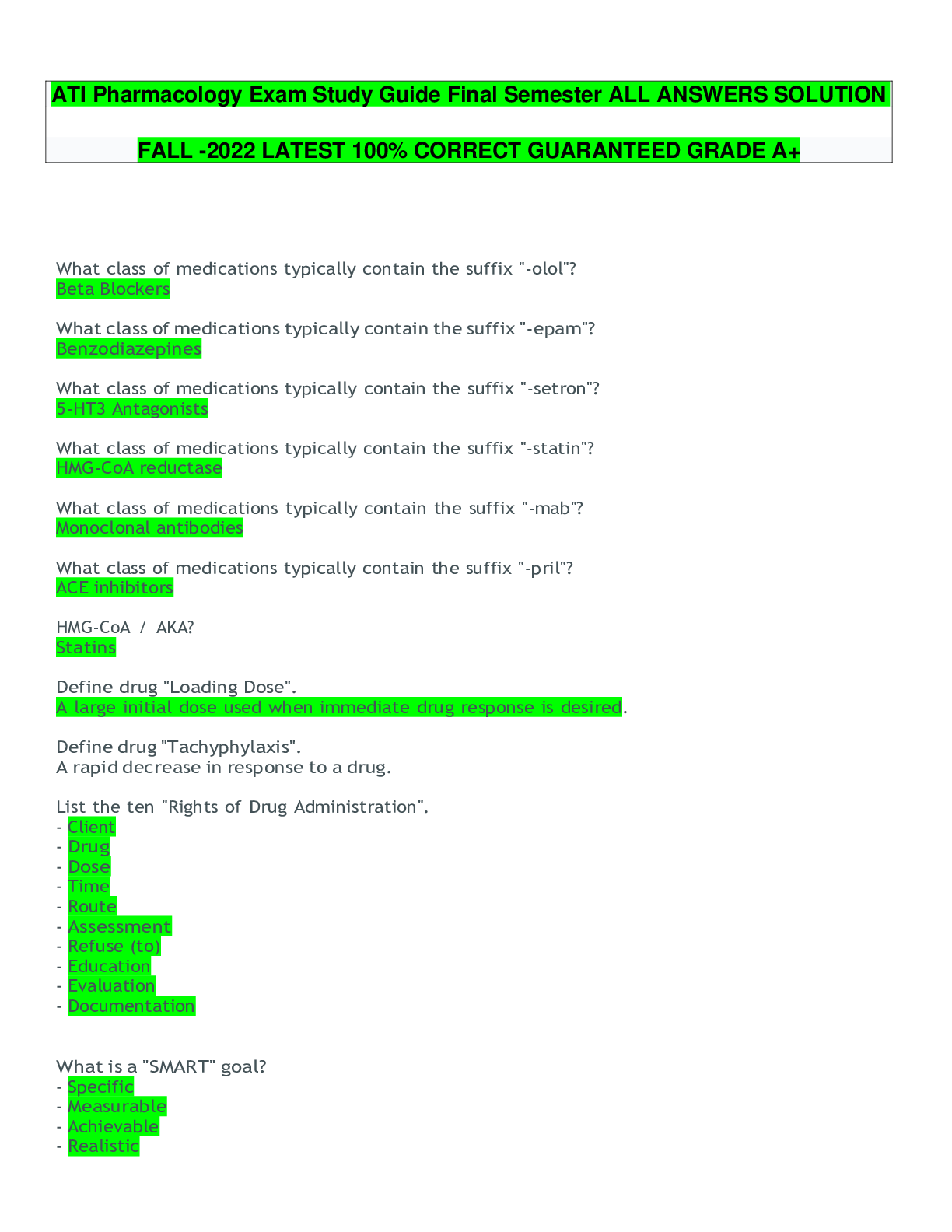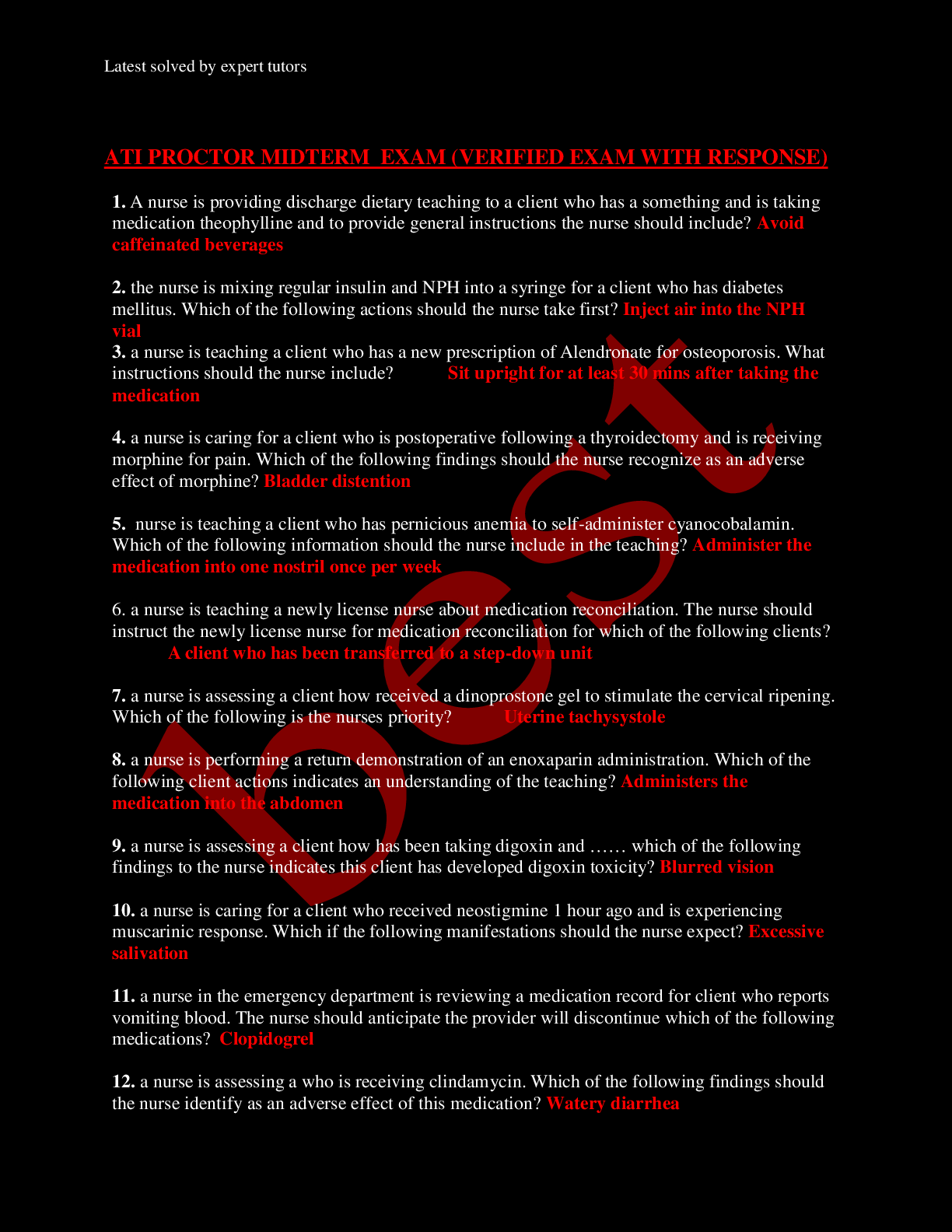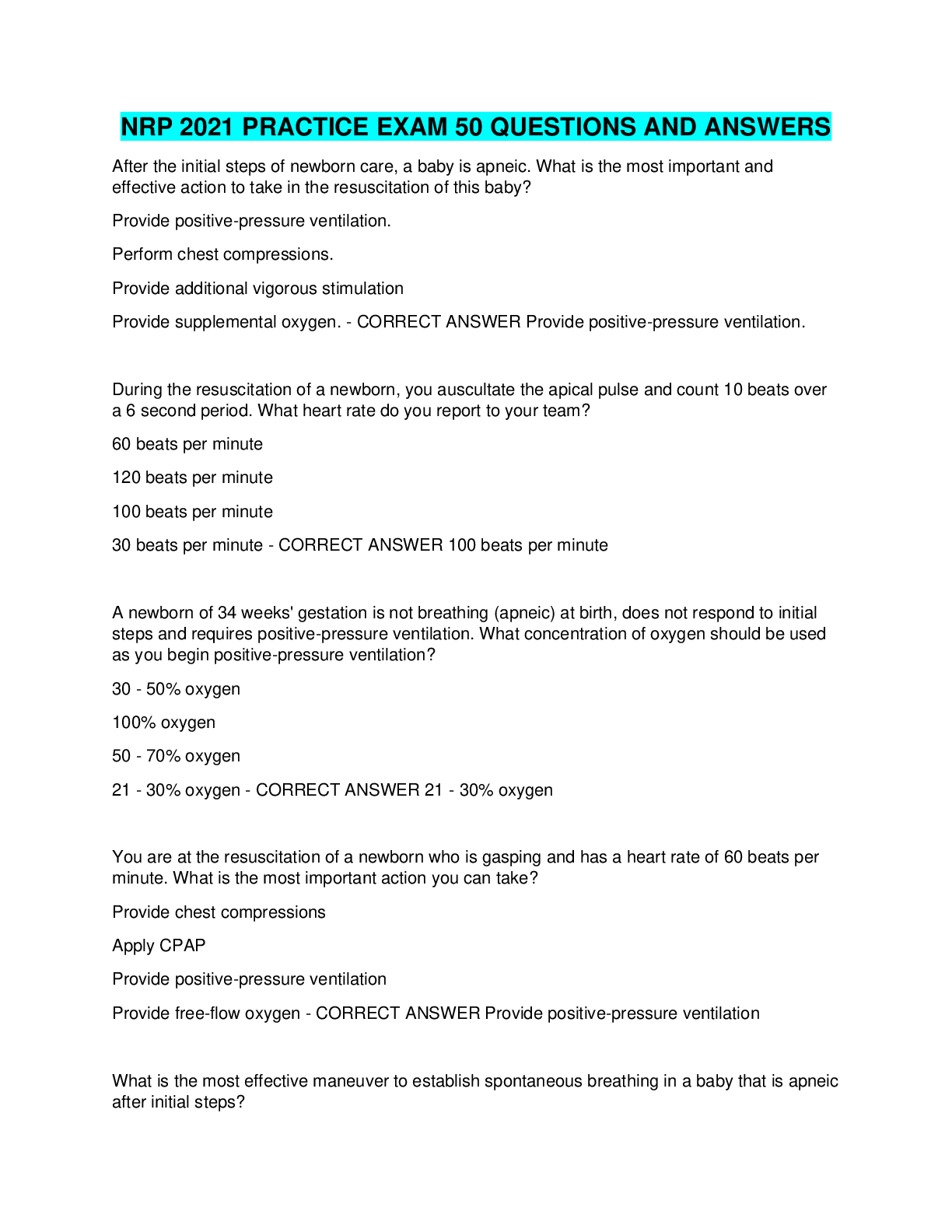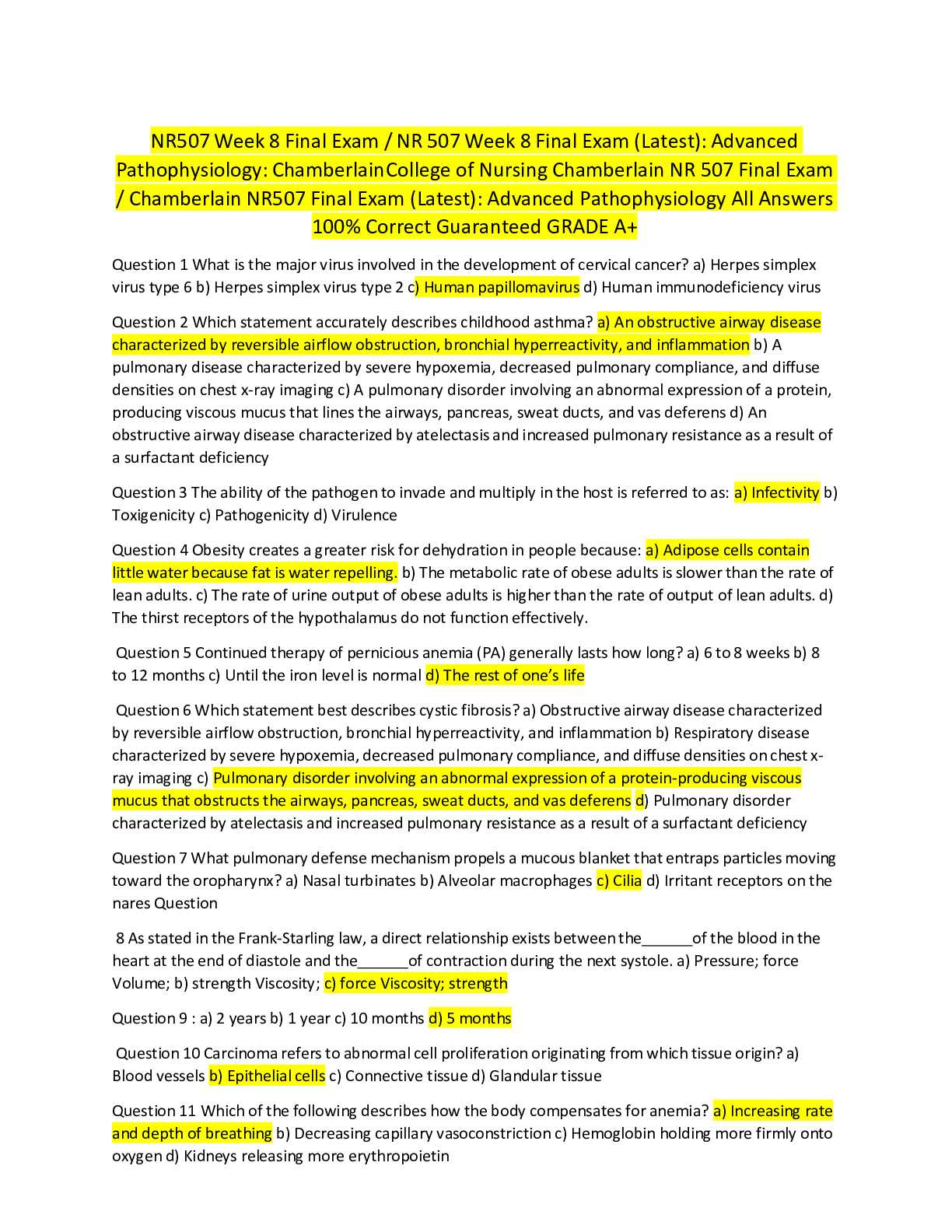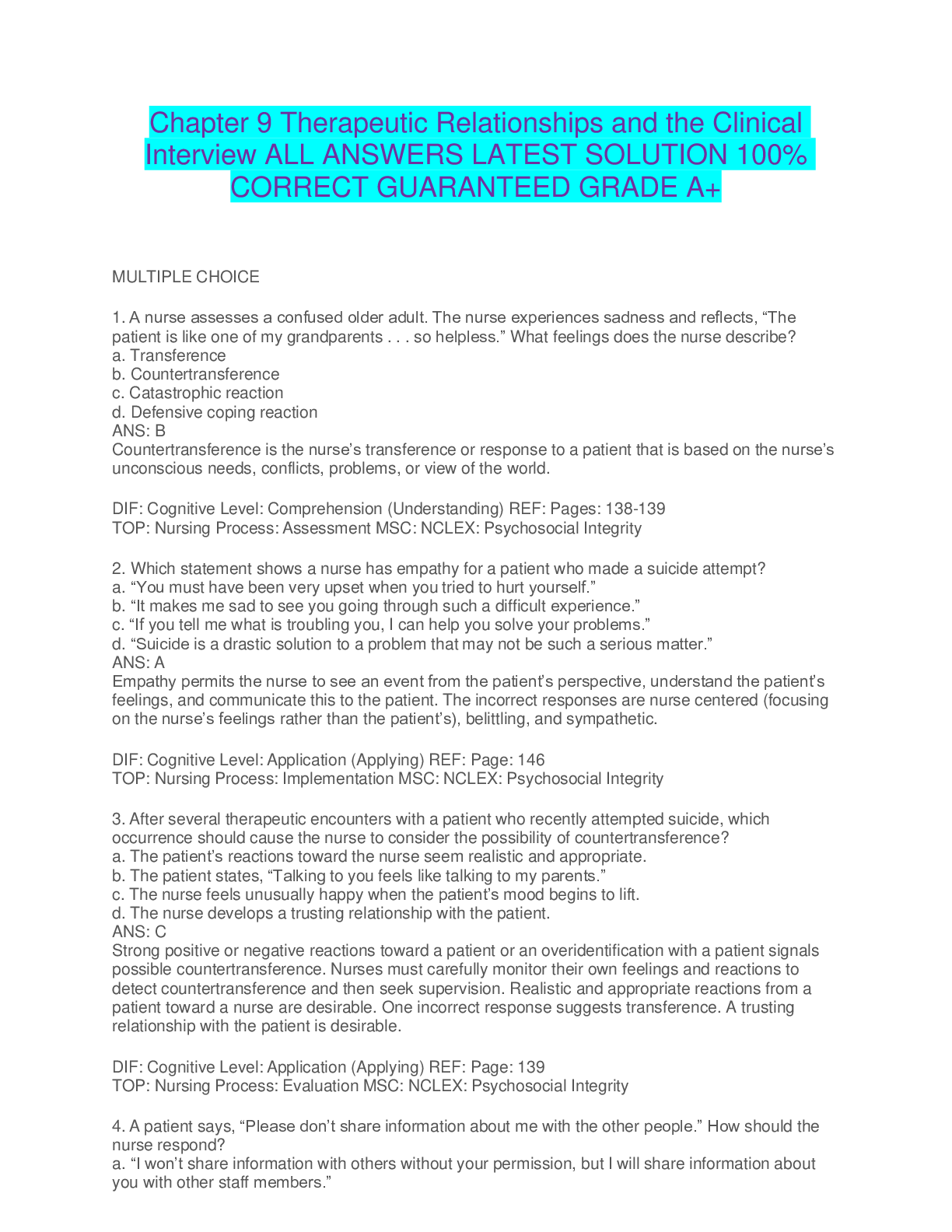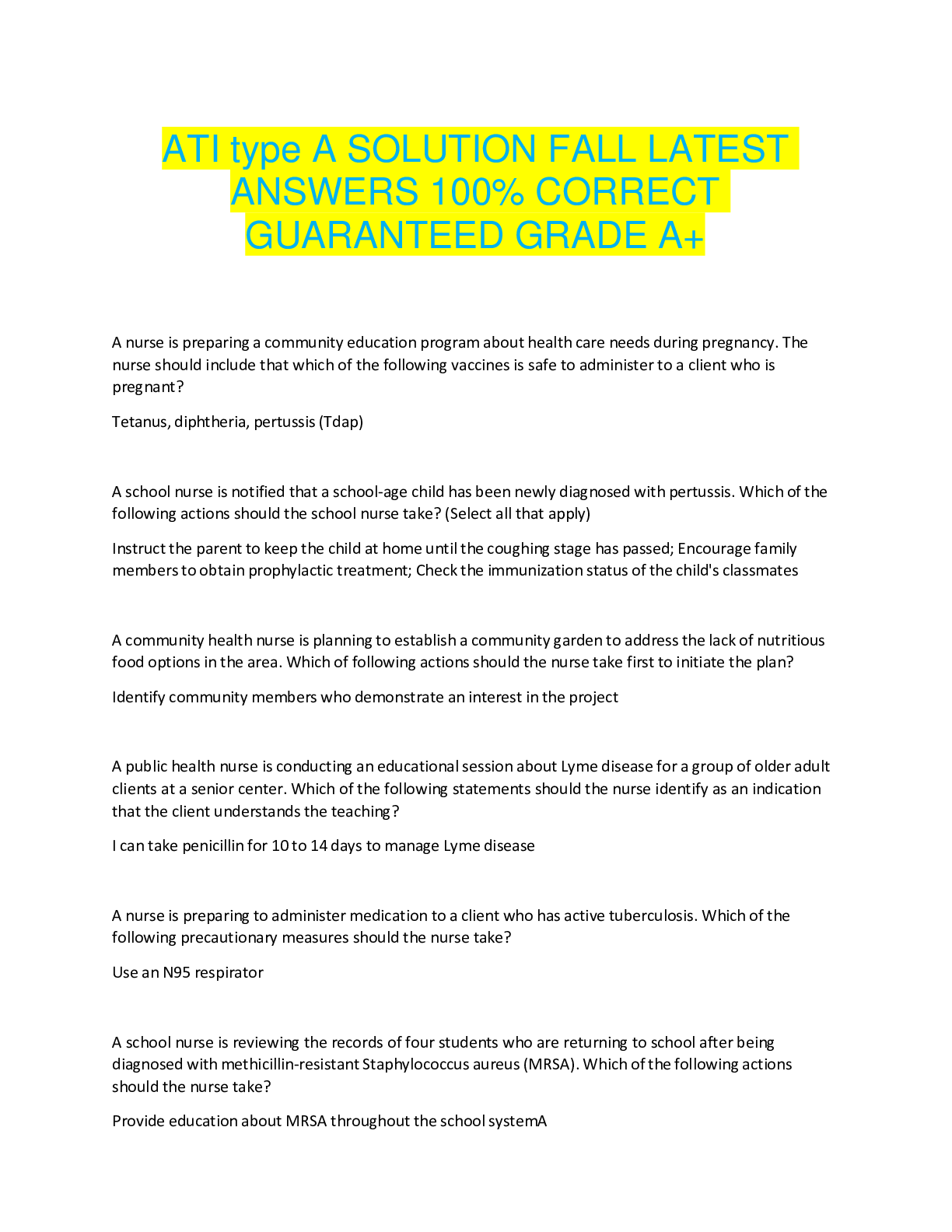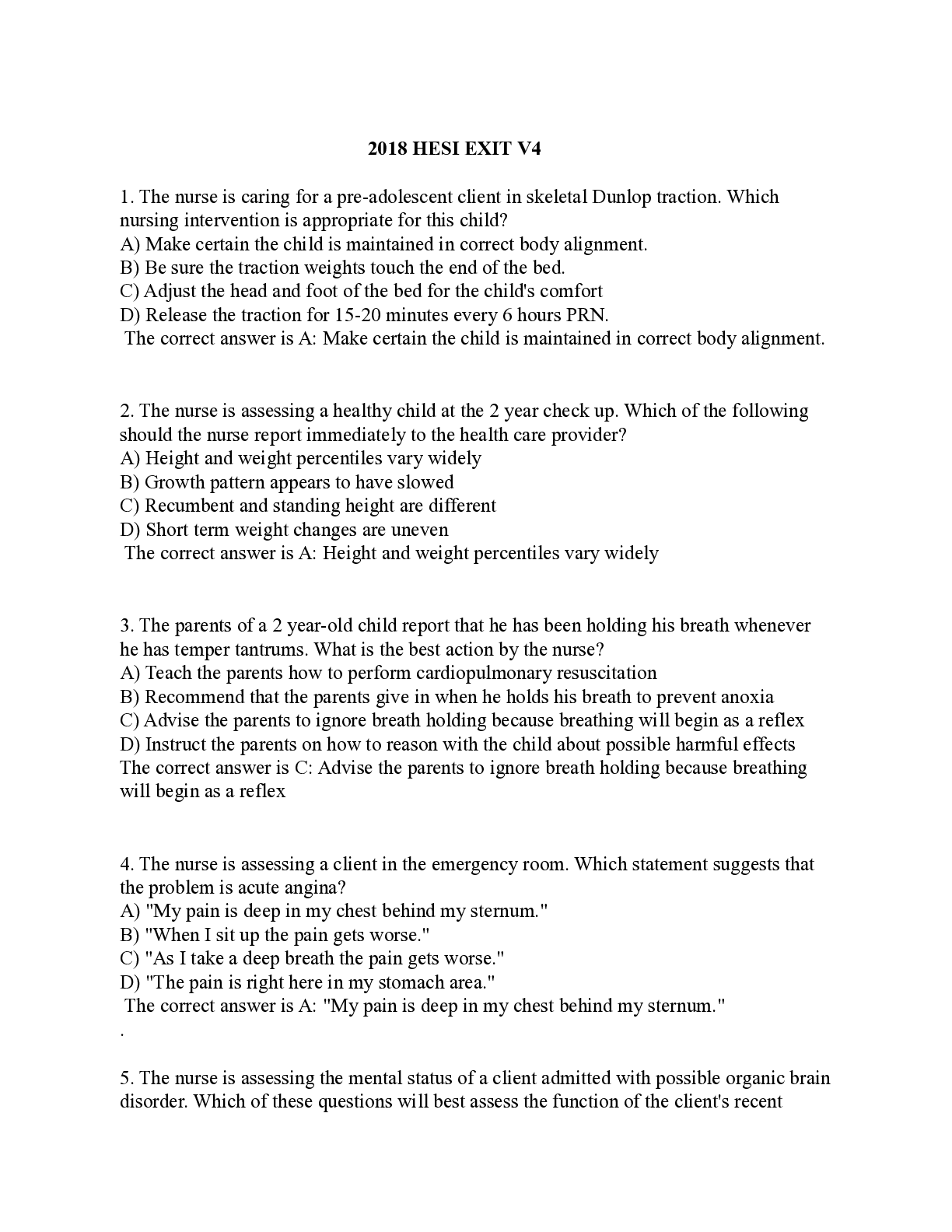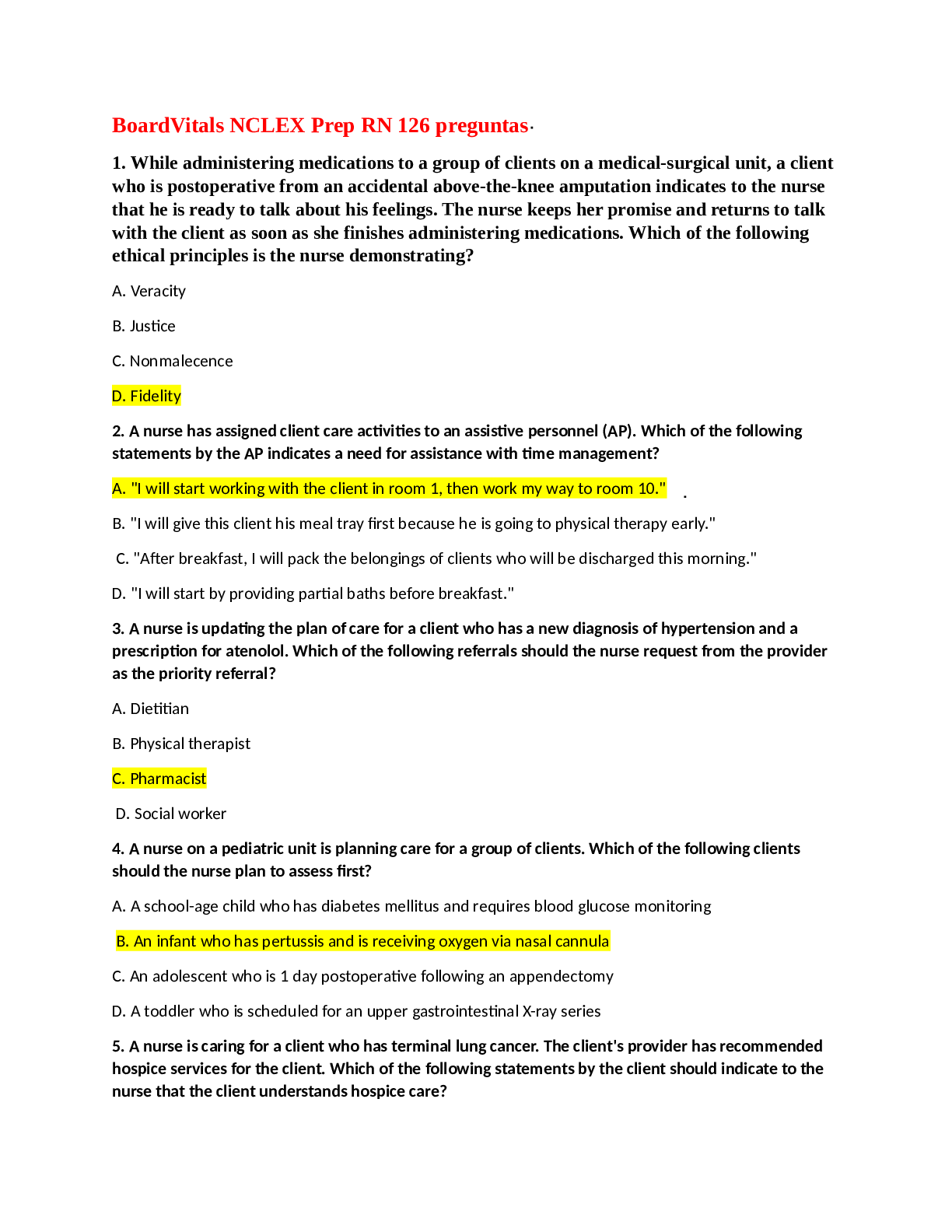Computer Architecture > EXAM > ISTM 210 TEST #3 ALL SOLUTION LATEST EDITION 2024 EDITION ALL 100% CORRECT GUARANTEED GRADE A+ (All)
ISTM 210 TEST #3 ALL SOLUTION LATEST EDITION 2024 EDITION ALL 100% CORRECT GUARANTEED GRADE A+
Document Content and Description Below
Database software is a well thought-out collection of computer files, the most important of which are called tables. These tables that consist of records (rows) of data separated by fields (columns) ... that can be queried (questioned) to produce subsets of information. What are you looking for in a database? criteria what is the most widely used database software in the world? Oracle What is the most important computer file in a database tables Tables Tables are where a database holds data. Tables consist of records (rows) separated by fields (columns) that can be queried (questioned) to produce subsets of information. The records retrieved by these queries become information that can be used to make business decisions records are ___ and fields are ___ rows; columns Database management systems (DBMS) Databases are created using software systems known as database management systems (DBMS). In a DBMS, data is stored in computer files called tables, and tables are connected to other tables with related information; hence, a relational database. relational database tables are connected to other tables with related information Business databases are ALWAYS DISTRIBUTED on a computer network for multiple users. It can be argued that the first database management systems were filing cabinets A typical filing cabinet might have three drawers marked with alphabetical characters. For instance, the top drawer might be labeled "A through H". Once a drawer is opened, alphabetical tabs separate folders. Other files that exist within a database can include reports, saved query files, and forms Reports reports display database information on screen or on paper Saved query files used to find specific populations (subsets) within databases forms overlay data tables and queries for more specific views of data Often forms are very simple and display only a single record from the table at a time. When creating a form, we must decide which fields from the table should appear on the form. We also decide how these fields should be arranged. Database designers construct databases by using entity relationship (ER) diagrams Entity relationship modeling (ERM) is a database-modeling method used to construct a theoretical and conceptual representation of data to produce a schema Simply stated, an ERM is a picture of a database's tables and how they relate to each other. A database schema is a "map" of data tables and their relationships to one another -- all the boxes with lines connecting relationships What do Database designers need to know? A BUSINESS They begin by finding out what a business does and how they do it. For instance, a business may have "customers" that tells the designer that the database will need a "Customers" table. Fields (attributes) The database designer finds out what is unique to those customers, like their first names, last names, addresses, and then these are included as fields (called attributes) in the "Customers" table on the ER design. Once the structure of the "Customers" table is complete, the database designer may find out that the business's customers place orders with them and sometimes more than one order. The database designer will construct an "Orders" table with fields like "Order Date", "Shipped Date", etc. "One to Many" relationship When the Orders table is complete, the database designer designates its relationship to the Customers table by understanding that "one" customer can place "one or many" orders establishing what is called a "One to Many" relationship between these two tables. Once the conceptual structure of the ERM is complete, the designer can start making the tables in the database. What else is a database designer expected to know? The database designer is also required to know what a business' expectations are of its DBMS. Like, what sort of "questions" or queries will the business require? Often, more experienced designers will consult with a business to help them realize the vast potential of a well-organized DBMS. At first glance, a DBMS seems restrictive especially relative to other business application software. Most business application software, like word processors or spreadsheets present the end user with a blank file, which is ready for use. Database software is different, requiring the end user to create their own files starting with tables and then relating them to each other "data validation" rules these rules help to ensure the data's integrity. Data integrity techniques attempt to avoid data input errors like typing mistakes. avoid data redundancy The nature and structure of a well thought-out database management system helps a business avoid data redundancy. For instance, only a singular table holds personal information about a person. A person's unique information, like name and address information, resides in just one place in the entire DBMS. Avoiding data redundancy ensures accuracy system wide throughout a DBMS which can reduce reconciliation errors immensely. having a name in one single table That means that if a DBMS consists of 23 forms and 124 reports, that include a person's name, the name will always display the same way. If the name is wrong, it only has to be corrected in one singular place; on the table that holds the "name" data and all forms and reports will display the name correctly. Databases store all kinds of sensitive information, like social security numbers, employee pay rates, and credit scores. DBMS systems have the ability to store information securely by giving certain end-users access to data and other end-users limited access to the same data. For instance, a human resource director may have complete access to all of a human resources database system; whereas, her employees may not be able to see all of the data in the same system, like a fellow employee's pay rate. Structured Query Language (SQL) is the most widely used standard computer language for relational databases as it allows a programmer to manipulate and query data. One of the most common uses of SQL is to query a table(s). PRONOUNCED SEQUIL A table might have the names of 10,000 book titles and their prices. If a person wanted to know which books in the data table cost more than $100, he could set up a SQL statement like the following: SELECT Title FROM Book WHERE Price > 100 ORDER BY Title The SQL above "Selects" the "Title" field (column) "From" the table named "Book" "Where" the book's "Price" is greater than $100. Once the query is run, the results of the query will be in "Order" of the "Title" field of the book(s). Data is fluid because it changes all the time business transactions are always in TABLES New books can be added and deleted from the data table in the above example using other SQL statements such as APPEND, DELETE and UPDATE queries SQL vs manual A very simple " UPDATE" query similar to the " SELECT" one above could be written to do the entire job in seconds. It would actually take longer to write the SQL update query (a few minutes) than it would to process the job. The update query would take a matter of seconds to do what would take days to do manually. Design mode is also called schema field mask restricts data input (zip code be 5 digits) 15.5 example reread and know the advantages and disadvantages or word, spreadsheets, and database mail merge A process that inserts variable information into a standardized document to produce a personalized or customized document. Zach could modify his existing REO Fact Sheet template to mail merge with only one other Word document Business database scenario ADVANTAGES -His new database was on a network drive now so he didn't have to worry about backups, that he rarely did anyway -He no longer had to manage 500 individual Word document files. He simply had one place where all of the REO information was held. -He was able to input and update information on his new REO Fact Sheet form in his data table. -Zach's database easily found and eliminated past input errors from his Microsoft Word days and kept him from making errors in the future. -Zach could also print his form and distribute it by simply querying complete REOs. If his boss requested changes to the REO Fact Sheet's configuration, Zach would make them in minutes. Printing vs online sharing She reminded Zach that his database was now on a network drive. She told Zach that if he chose too, other people throughout the bank on the same network could look at his REO Fact Sheet form. She described a few modifications to the form so no one but Zach could edit the underlying database. Instead of ever printing on paper, REO Fact Sheets and their associated information would be distributed completely electronically through the bank's network. form configuration She wanted to know why he distributed information only in the REO Fact Sheet form configuration. She suggested he could configure his data in an almost infinite variety of ways like reports and new forms that would be distributed on the network and eliminate the need for other bank departments to compile and make their own reports. "filtering" the ability to add a filter to a data table that would only display specific information. For instance, a filter could easily be added to the "State" field by inserting "AZ" and, in turn, the data table would only display information for Arizona. What filter did Zach need? Zach knew exactly where he needed a filter from the moment he knew how the technique worked. From the very beginning of his database system, Zach included a filter in the "Complete or Incomplete" field to only display REO's that had complete information. This meant that any REO without complete information was hidden from all users, and all reports. Business Database Scenario Disadvantages One disadvantage in this situation was that Zach was only showing the REO foreclosed properties that had a completed file. This was an issue because all other parts of the bank were using this '400' completed number for their job when there were actually '500' properties in total. CH.16 !!! Cloud computing or the "cloud" the Cloud is simply using computer resources like a hard drive or software that exists on another computer connected by a network, typically the Internet. Internal hard drive advantages: speed, storage, and file management disadvantages: have to be backed up on a regular basis. To prudently back up a hard drive, it makes sense to back-up to an external hard drive. The contents of a back up must be taken off site to prudently complete the back up. Why cloud over hard drive A better way to back-up your internal hard drive is to an off-site hard drive that you connect to through the Internet. If the original internal hard drive contents are corrupted or lost, like in a fire, the internal hard drive's contents are still intact at a different location. That's the Cloud, or at least a small part of it. First to do use the cloud Companies like GoDaddy.com have offered off-site file storage for years, but they called them iDrives (Short for " Internet Drive"). In the past, the problem with iDrives was that the Internet was just too slow to store and back-up data and information like spreadsheets and word documents. That's all changed with faster Internet speeds, and iDrives morphed into the Cloud, or at least part of it. What was the precursor of the Cloud? Internet Drives Why didn't iDrives catch on? Internet was too slow As long as you're going to back up data on to a "Cloud Drive," a hard drive in the Cloud, why not bypass your internal hard drive altogether? If your resume was permanently stored on a Cloud Drive, you would still access it through your own computer's file manager, but it would be somewhere else (in the Cloud). If your resume file (MyResume.docx) was on a Cloud Drive, it wouldn't require back up, as the Cloud Service Providers (CSP) like Google, Microsoft, or DropBox would provide back up automatically. Cloud Service Providers (CSP) Companies that provide cloud backup automatically EX: Google, Microsoft, or DropBox notes: Amazon, iCloud, Egnyte, OpenDrive Cloud drive advantages automatic back up and access from any Internet enabled computer Cloud Drive disadvtanges Privacy groups have raised concerns about the Cloud because your Cloud Service Provider (CSP) can access your data and information stored on their Cloud. CSP's, like Amazon, require their Cloud customers to agree with their " Terms of Service" (TOS) before they are willing to let you port your data and information to their Cloud. Amazon terms of agreement "Our Right to Access Your Files. You give us the right to access, retain, use and disclose your account information and Your Files: to provide you with technical support and address technical issues" This is giving them the right to sift through your data; many say that as long as none of your data and information is illegal, like illegal MP3 music files, then there is nothing to worry about. As the Cloud evolves, there will be much to anticipate regarding privacy and accessibility. Advances in existing technologies as well as the emergence of new ones will have to be made to ensure that the Cloud is safe and private. Infrastructure as a Service ( IaaS) This is one of the main categories of Cloud Computing. This give you the ability to sit at home or work and use your own keyboard, mouse, and monitor, but connect to their computer and all of its resources like Photoshop (software) and storage via the Internet. From a business standpoint, a third party IaaS provider host like Windows Azure or Google Compute Engine supplies a computer software applications like Adobe Photoshop, servers, and storage in their Infrastructure as a Service, all connected via the Internet. on-demand If the organization needs more computing, IaaS can quickly adjust and supply more computing power because it is considered on-demand. pay-as-you-go model The IaaS customer can use a pay-as-you-go model (per hour, per week, per month, etc.) that eliminates the cost of having to buy new computers. disadvantages of IaaS systems If an organization depends on IaaS and the Internet goes down, its employees cannot get work done. If the Infrastructure as a Service goes down, the organization using it could potentially suffer because it is essentially without computing power, and that could result in a reduction of output. Storage as a Service (StaaS) Storing, or renting space from a CSP is called "Storage as a Service" (StaaS). Because of economies of scale, CSPs like DropBox can provide storage much more cost effectively than a single business. A business can certainly buy storage devices for excess storage needs, but Cloud storage is infinitely less expensive. EX: amazon elastic computer cloud, dropbox, google drive, Onedrive, rack space, and fiber town ($2 or less per gig per year) rackspace San Antonio provider that hires Aggies disadvantage of StaaS One criticism of StaaS is that it requires the business using it to increase their bandwidth required to access their Cloud, which is an added cost. And, unable to use without the internet software disadvantage of the cloud (solution below) You may pull a Microsoft Excel spreadsheet from the Cloud to your microcomputer's RAM, but you won't be able to work with it unless Microsoft Excel is loaded on that microcomputer. Although your Cloud can be accessed from virtually any Internet enabled computer, the application software needed to run a specific file, like a spreadsheet or word processing document, needs to be present. Software as a Service (SaaS) SaaS, sometimes called " On-Demand" software is when the CSP installs and operates application software in the Cloud that the Cloud user can use. For instance, if the application software needed to use a spreadsheet is already installed in your Cloud, you will be able to use it on any Internet enabled computer, even if the particular application software is not loaded locally on that computer. This eliminates the need to install and run application software on the Cloud user's own computer, that could potentially save businesses enormous amounts of money. Consider a small startup business of twenty-five people that is trying to secure venture capital from a bank They can go the traditional route and include the following on the spreadsheet in their business plan: Lease office space, buy computers, wire all the computers together to make a hard-wired network (a small Local Area Network) Now, think about your business mitigating some of these startup costs with Cloud Drives with SaaS. You'll still need an internet computer, but, cloud Drives can be purchased and administered just like a hard-wired network, with the same types of permissions. All twenty-five employees will be able to access the same Cloud "network" as they would the hard-wired network; therefore, the Cloud replaces the need and cost for the hard-wired network. Since the Cloud is accessible from virtually anywhere, it also replaces the need and cost for office space. Ultimate effect of Cloud drives for a small business: Software as a Service (SaaS) could replace the need for twenty-five licenses for Microsoft Office 2012 by employing "Cloud Software" like Google Apps, Apache OpenOffice, QuickBooks Online, SalesForce.com, and Microsoft Office 365. Instead of a capital outlay of $8,750 for Microsoft Office, the startup company simply pays a much smaller monthly or yearly fee to "rent" SaaS software like QuickBooks. By employing the Cloud and SaaS, the startup business reduced its costs dramatically and, by implementing a virtual office space, extended its global reach. Without the Cloud, the startup's initial costs were a whopping $219,250. With the Cloud they were $29,500, an initial startup savings of $189,750. Small business example: is it sustainable? Many would argue that this model is not sustainable because people need to be managed at a more personal level to have a more coordinated business effort as opposed to twenty-five independent people scattered in separate locations. Large businesses that lease office space may not want to leverage the Cloud because they essentially pay for a workspace for their employee(s) five days a week. If they let employees work from home two of those days, it doesn't mean they enjoy cost savings on office space, as they still have to pay for all five days. Can MS Office really be replaced when some consider it an essential business tool? Think about Apache's OpenOffice as an alternative to MS Office with a modified Cloud business environment. Apache OpenOffice is an open-source business software suite that has a word processor like Microsoft Word, a spreadsheet like Excel, presentation software like PowerPoint, and a database like Access. Apache's OpenOffice name It used to be called OpenOffice.org and was administered by Sun Microsystems, then ownership went to Oracle, and it is now in the hands of Apache where it is known by its current name, "OpenOffice." Apache's Open Office EQUIVALENTS -"Writer" is similar to Microsoft Word, which can produce Portable Document Files (PDFs) and web pages. -"Calc" is the OpenOffice spreadsheet equivalent to Microsoft Excel -"Impress" is the presentation software similar to Microsoft PowerPoint -"Base" is the database application like Microsoft Access -"Draw" is the graphics editor similar to Adobe Photoshop. How much does OpenOffice cost? FREE Platform as a Service (PaaS) PaaS is when a Cloud provider supplies a computer platform (like Windows) through the Internet. Also provided in PaaS are programming applications, database, and web servers. Some Cloud PaaS providers include Amazon's Elastic Beanstalk, Force.com, and Google's App Engine. Advantages of PaaS One advantage of PaaS is that large business organizations can decide to contract Cloud services to replace many things they already do, like administering their own platforms, their own programming environments, and their own database. That could mean that the business would save costs and complexity because it no longer needs as many information technology people who traditionally do these jobs. It also means that the business can buy as much or as little PaaS as it needs. From a pure cost analysis standpoint An organization can see which costs more: employing PaaS, or keeping its computing services in-house. From a business standpoint, there is much more to consider before investing in PaaS. disadvantages with PaaS: A business organization can be locked in to a PaaS that may not be flexible enough and allow the company to grow. It also points out that, had it kept its information technology staff, the business would still have had the ability to do what it considers necessary to grow. If the Internet is down, is the Cloud available? No different types of clouds public cloud- owned and operated by third party; deliver stuff via the internet private cloud- used exclusively by one company/organization, pay someone to have private network hybrid- combo of both private/public. public can be for emails and private can be for high ball private finances into a company CH. 17 !!!!! Business Intelligence BI refers to an assortment of software applications used to analyze an organization's raw data. BI can be described as computer applications that change data into significant, meaningful information that helps organizations make better decisions. Keep in mind that data is raw, unorganized facts, and information is essentially processed data that means something. BI fixes not having enough inventory, too much, or using past guess work and failing •Business intelligence (BI) is often described as "the set of techniques and tools for the transformation of raw data into meaningful and useful information for business analysis purposes". Predictive way Now you can start to use your data in a predictive way. For instance, imagine software that will cross-reference your subset's data with other (external) data to figure out what kind of wipers are used by the cars in your radius based on year, make and model. return on investment (ROI) Imagine applying Business Intelligence to every product in your store. It looks like BI might be a great return on investment (ROI) after all. An auto parts store with "just right" inventory would be far more profitable and flexible. Business Intelligence: How did we get here? In a way, we've always had Business Intelligence. Businesses throughout history have tried to recognize trends to best serve their customers and in turn, to then try and become more profitable. Essentially, organizations have always tried to predict the future. (1950s started using and processing data for decisions) Decision Support Systems (DSS) computer-based systems that support an organization's decision-making activities. For example, loan officers at a bank use DSS to verify the credit of a loan applicant. A simple spreadsheet is DSS that calculates possible revenues and expenses which can help someone decide whether a start-up business is viable or not. --- USER FRIENDLY At the dawn of the Internet, many people envisioned a "YouTube-like" website, but Internet speeds simply weren't fast enough to be a feasible business option. Early iDrives eventually morphed into the Cloud as speed and space became more inexpensive, but the Cloud had to wait for its time before it became reality. Big data a broad term for datasets so large or complex that traditional data processing applications are inadequate. Data would also include smartphone metadata, Internet usage records, social media activity, computer usage records, and countless other data sources, so it could be sifted for patterns and trends. When was BI born? As data became more easily collected, the term Business Intelligence was born. The vast amounts of data that organizations wanted to collect wouldn't just be in readily available, neat and tidy database tables either. Structured Data resides in fixed formats. This data is typically well labeled and often with traditional fields and records of common data tables. Structured data doesn't necessarily have to be "table-like," but needs to at least have recognizable patterns that allow it to be more easily queried, searched, and in a standard format. Unstructured Data is disorganized data that cannot be easily read or processed by a computer because it is not stored in rows and columns like traditional data tables. Imagine collecting massive amounts of Facebook messages and Instagram posts to determine future fashion trends. Organizations attempt and do collect videos, documents and all manner of fragmented data to eventually make sense of it. A whopping 80% of all data is unstructured! Semi-structured Data lands somewhere in-between Structured and Unstructured data and can possibly be converted into structured data, but not without a lot of work. How much of all data is unstructured? 80% Four V's of Big Data Volume, Velocity, Variety, Veracity Volume Refers to the amount of data collected by an organization. How much data does your business need, and further, where do you keep it once you've collected it? Velocity How fast can you collect data, and more importantly, how quickly can you analyze it? Variety You may have identified what data you wish to collect, but is it Structured, Semi-structured, or Unstructured? Very likely it is a combination of all three, which could potentially throw a wrench into your data collection gears. Veracity Is the data your organization collected any good? Just because some other business amasses data you may want, doesn't necessarily make it trustable or valuable. Lots of data sources have data that is not "clean," meaning it may be too fragmented to be valuable or usable, or that it was simply collected poorly in the first place. Make sure data is valid: GIGO Garbage in Garbage out if you don't put good data in the system, it produces bad data output Customer Relationship Management (CRM) used to TRACK and organize communication with customers How to store and manage data First things first: Take an inventory of the data your organization makes, and figure out who or what makes it. Second: find a place to keep the data you want to retrieve When taking inventory: -Maybe some data resides in your company's Customer Relationship Management (CRM) system that holds information about sales, marketing, customer service records, and much more. -You also know that data resides in the bank's Marketing Automation Services system that has endless customer facts and figures. -What about the bank's involvement in Social Media Platforms that can uncover what your customers are thinking? One more thing: Remember that most of this data is unstructured, 80% of it. It would be foolish to grab and store every piece of data you can get your digital hands on Not unlike the auto parts store, you want just the right amount of data, not too much, and not too little. One way to decide what kind of data you require is to think about JEOPARDY Jeopardy doesn't ask its contestants to provide answers, it asks for the questions. What questions do you need to answer? Coming up with questions goes a long way towards the answers you need as well as toward the creation of a baseline for what data you need to collect. Data Warehouses are used to consolidate disparate data in a central location, and lots of it! It's not unusual for a data warehouse to hold yottabytes of data! EX: oracle, IBM, SAS, Teradata What is Oracles's CRM called? SIEBEL; collection of data from variety of sources used to support decision making to support intelligence Datamart Maybe you're a smaller organization, so instead of using a data warehouse, you could opt for a Datamart that is a smaller, more focused data warehouse. Datamarts limit the complexity of databases (just one section of business i.e. marketing), so you can't "answer" as much as with a Data Warehouse, but they are cheaper to implement than a full warehouse. querying is a tool that lets you ask your data questions that in turn lead to answers, and eventually decisions. It is important to note that ETL must happen: IN ORDER first extracting the data, then transforming data so it fits into your data warehouse or datamart, and then loading the data into the data warehouse or datamart. Enterprise Resource Planning (ERP) One of ERPs main function's is to centralize an organization's data so that it ends up being a wealth of data with value across the organization. can eat bandwidth and storage at an alarming rate and size Extract Once you've determined where your data resides, you can start extracting it, often from Customer Relationship Management (CRM) or Enterprise Resource Planning (ERP) software. The extraction step sometimes grabs unstructured data like text notes to semi-structured or structured data by tagging it with metadata. For instance; tagging with metadata could mean extracting country names from an unstructured sales database and loading them into a column form and labeling it "Country Names." Transform (normalize) Once you've extracted data, it needs to become normalized. Data is no good to you unless it's organized. ***Normalizing data means that your data is typically organized into the fields and records of a relational database. Normalizing provides the standard data format required to analyze data. Load Once data is transformed and normalized, it's ready to be finally transferred into the data warehouse or datamart. Loading sometimes happens weekly, daily, or even hourly. The more often this is done, the more up-to-date analytic reports are possible, and the more timely they can be. ETL example to water Imagine the vast amount of time and money it costs to build the water pipes and infrastructure to lakes and rivers and take it back to your holding tanks (Extract). The wider the water pipes, the faster water fills your tanks, but a few words of caution; wider water pipes are way more expensive. You purify and prepare it to be added to your ocean (Transform), now pour the purified water into your ocean (Load). Check that; pour your water into the many oceans (Data Warehouses) you administer. Then analyze the water in the oceans. What is the point of the water metaphor? The water metaphor illustrates the massive amounts of time, money, bandwidth and storage space required for ETL. It would be wise to start calculating the Return on Investment (ROI) to find out whether it's worth it. Hadoop Hadoop is a toy elephant owned by Doug Cutting's young son. In 2005, Cutting and Mike Cafarella created software that was originally developed to support distribution for a search engine. They naturally named it Hadoop. Hadoop evolved as an infrastructure for storing and processing large sets of data across multiple servers. It is open-source software framework written in Java for distributed storage and distributed processing of very large data sets on computer clusters built from commodity hardware. Advantages of Hadoop Hadoop uses a cluster system that allows files to be stored on multiple servers. Unlike storing oceans of water (centralized data), Hadoop attempts to identify lakes and rivers (data files on other multiple servers). Hadoop is flexible enough that it allows for one query to be issued that searches through multiple servers. Disadvantages of Hadoop Hadoop is not the best for on the fly, or ad hoc queries, and is very difficult to implement and run. Typically, Hadoop needs a highly qualified data scientist(s) to run it. Right now, Hadoop is best for large companies like Facebook.com, eBay.com, and American Express that create Terabytes and Petabytes of data every day. One last way to look at it: If Extract, Transform, and Load (ETL) brings the mountain to Mohammed, then Hadoop brings Mohammed to the mountain. Map Reduce is the processing arm, or engine of Hadoop. It allows data to be queried and processed directly on the server where it lives, instead of moving the data across the network to be analyzed on the computer. In Map Reduce, only the query is transported through the network. MAP --- SHUFFLE --- REDUCE What is map reduce like? Map Reduce is like little computer minions that search out and query data where it resides, and process the query instead of dragging it back to a large centralized server, not unlike what Google does when it sends out Web bots to find new information for its search engine. Data Analysis is basically applying statistics and logic techniques to define, illustrate, and evaluate data. Simply stated, Data Analysis attempts to make sense of an organization's collected data and turn it into useful information and validate its future decisions, like what product to sell or whom the organization should hire. Some concept of data analysis: -data mining -topic analytics -text analytics -business analytics forms of business analytics: -descriptive, predictive, and decision analytic Data Mining sometimes called Data Discovery, is the examination of huge sets of data to find patterns and connections, and identify outliers. EX: Netflix movie recommendations slice and dice Taking out parts of the data you need Topic Analytics tries to catalog phrases of an organization's customer feedback into relevant topics. For example, if a customer said, "the barista was friendly", that would be categorized under the topic "Employee Friendliness." Text Analytics sometimes called Text-mining, hunts through unstructured text data to look for useful patterns, like whether their customers on Facebook.com or Instagram.com are unsatisfied with the organization's products or service. Business Analytics attempts to make connections between data so organization's can try to predict future trends that may give them a competitive advantage. Business analytics can also uncover computer system inadequacies within an organization. (BANA old name - BA to many - info department now) The following are forms of business analytics: -Descriptive, predictive, and decision Descriptive Analytics is the baseline that other types of analytics are built. Descriptive Analytics define past data you already have that can be grouped into significant pieces like a department's sales results, and also start to reveal trends reactive strategies --WHAT HAS HAPPENED Predictive Analytics attempts to reveal future patterns in a marketplace, Essentially trying to predict the future by looking for data correlations between one thing, and any other things that pertain to it. number of staff next year based on sales trends ---WHAT COULD HAPPEN Decision Analytics builds on Predictive Analysis to make decisions about future industries and marketplaces. Decision Analytics looks at an organization's internal data and then analyzes external conditions like supply abundance and then endorse a best course of action. Recommends course of action based off of likely outcomes of each of them - are the side effects worse than the illness --- WHAT SHOULD WE DO Who benefits from BIG data? everyone if you can harness it Chief Analytic Officer (CAO) New position developing Data Visualization is the graphic display of the results of data mining, analytics and BI in general, typically in real time. Many times, data and information is just too massive and confusing to rely on numbers, so products like PowerPoint and Dashboards have become invaluable tools. Tableau (BI) B.I. product that allows a company to visualize the data and what you want in real time Sometime it's hard to imagine a program like Microsoft's PowerPoint is all that valuable However, since PowerPoint is one of the best presentation tools in the market, it has found a place in Business Intelligence, specifically in Data Visualization. Dashboards Dashboards are easy-to-use graphical interfaces that characterize specific data analysis through visualization. Not everyone wants to deal with BI programming using Structured Query Language (SQL) or other programming tools. Dashboards make it a lot easier to make sense of the data and see the resulting information. ETL an acronym for Extract, Transform, and Load, tools that are used to standardize data across systems, allowing it to be queried. database (class) !!!!!!!!!! entity An entity is anything about which the organization wishes to store data. At your college or university, one entity would be the student. attributes/ fields Information about the attributes of an entity (e.g., the student's ID number and birth date) are stored in fields. ID numbers are NOT arbitrary! cats being in the 1000s and dogs in the 2000s is not on accident record All the fields containing data about one entity (e.g., one student) form a record. file A set of all related records forms a file (e.g., the student file). Database A set of interrelated, centrally coordinated files forms a database. ex: student file and advisory file and class file make up a database Primary Key A field (or group of fields) that uniquely identifies a given entity in a table; In some tables, two or more attributes may be joined to form the primary key. Foreign Keys USED to link tables together A foreign key is an attribute in one table that is a primary key in another table. Alternative for storing data -One possible alternate approach would be to store all data in one uniform table. -For example, instead of separate tables for students and classes, we could store all data in one table and have a separate line for each student x class combination. update anomaly -Suppose Alice Simpson changes her phone number. You need to make the change in three places. If you fail to change it in all three places or change it incorrectly in one place, then the records for Alice will be inconsistent. -This problem is referred to as an update anomaly. insert anomaly improper database organization that results in the inability to add records to a database -What happens if you have a new student to add, but he hasn't signed up for any courses yet? -Or what if there is a new class to add, but there are no students enrolled in it yet? In either case, the record will be partially blank. -This problem is referred to as an insert anomaly. delete anomaly -If Ned withdraws from all his classes and you eliminate all three of his rows from the table, then you will no longer have a record of Ned. If Ned is planning to take classes next semester, then you probably didn't really want to delete all records of him. -This problem is referred to as a delete anomaly. Second alternative for storing data -Another possible approach would be to store each student in one row of the table and create multiple columns to accommodate each class that he is taking. This approach is also fraught with problems: -How many classes should you allow in building the table? -The above table is quite simplified. In reality, you might need to allow for 20 or more classes (assuming a student could take many 1-hour classes). Also, more information than just the course number would be stored for each class. There would be a great deal of wasted space for all the students taking fewer than the maximum possible number of classes. -Also, if you wanted a list of every student taking MGMT-3021, notice that you would have to search multiple attributes. Third alternative to storing data (solution): -The solution to the preceding problems is to use a set of tables in a relational database. -Each entity is stored in a separate table, and separate tables or foreign keys can be used to link the entities together. Normalized Database -Data is consistent -Redundancy is minimized and controlled -Attributes appear multiple times only when they function as foreign keys -The referential integrity rule ensures there will be no update anomaly problem with foreign keys. Database Administrator (DBA) the person responsible for coordinating, controlling, and managing the database. They set restrictions and set permission An important feature: data about various things of interest (entities) are stored in separate tables; makes it easier to add new data to the system and redundancy is minimized and controlled. •You add a new student by adding a row to the student table. •You add a new course by adding a row to the course table. •Means you can add a student even if he hasn't signed up for any courses and you can add a class even if no students are yet enrolled in it. Space is also used more efficiently than in the other schemes. There should be no blank rows or attributes. Deletion of a class for a student would cause the elimination of one record in the student x class table. -The student still exists in the student table. -The class still exists in the class table. -Avoids the delete anomaly. Access (textbook) !!!!! Access menu ribbon -file -create -External Data menu tab: contains the tools used to import data into Access -The Database Tools menu tab: contains a set of advanced utilities for working with your database The navigation pane The Access navigation pane displays the objects in a database file. You can set the navigation pane to display only certain types of objects to simply what you see in the navigation pane. Four types of objects in access Tables, queries, forms, and reports Definition of four types of objects in access -Tables: are used to store the data (entities) in Access. A table consists of columns, which store data fields, and rows, which store database records. -Queries: are used to find the specific data you need from the database. A query can be constructed to locate related data across more than one table. -Forms: present the data in a table in a separate window one record at a time. They are used to help with entering new data into a table -Reports: allow you to organize and present the data in your database. Reports are used to present the data in a meaningful way to aid in managerial decision-making. View menu -Object view: displays the finished object -Design view: is used to edit the object -Layout view: is like the design view, but it provides fewer options for manipulating the object (easier to use) Records are stored in rows of tables attributes are stored in the columns of tables principles for naming fields 1. names of the fields in your tables should be meaningful and descriptive 2. Access will allow you to use spaces in your field names, though this is not recommended (not universal) 3. use only letters and numbers (no symbols or special characters) Short Text used to store most data that won't be treated like a number (used in calculations) such as text, telephone numbers, zip codes, etc. The Short Text data type is limited to 255 characters. These characters can be any combination of letters, number, and symbols. Long Text used to store larger amounts of text. The Long Text data type is limited to 65,536 characters and can contain any combination of letters, numbers, and symbols Number used to store positive and negative numbers. The Number data type may contain decimal places. The Number or Currency data type must be used when you expect to perform calculations on the data in a field [Show More]
Last updated: 3 months ago
Preview 1 out of 32 pages
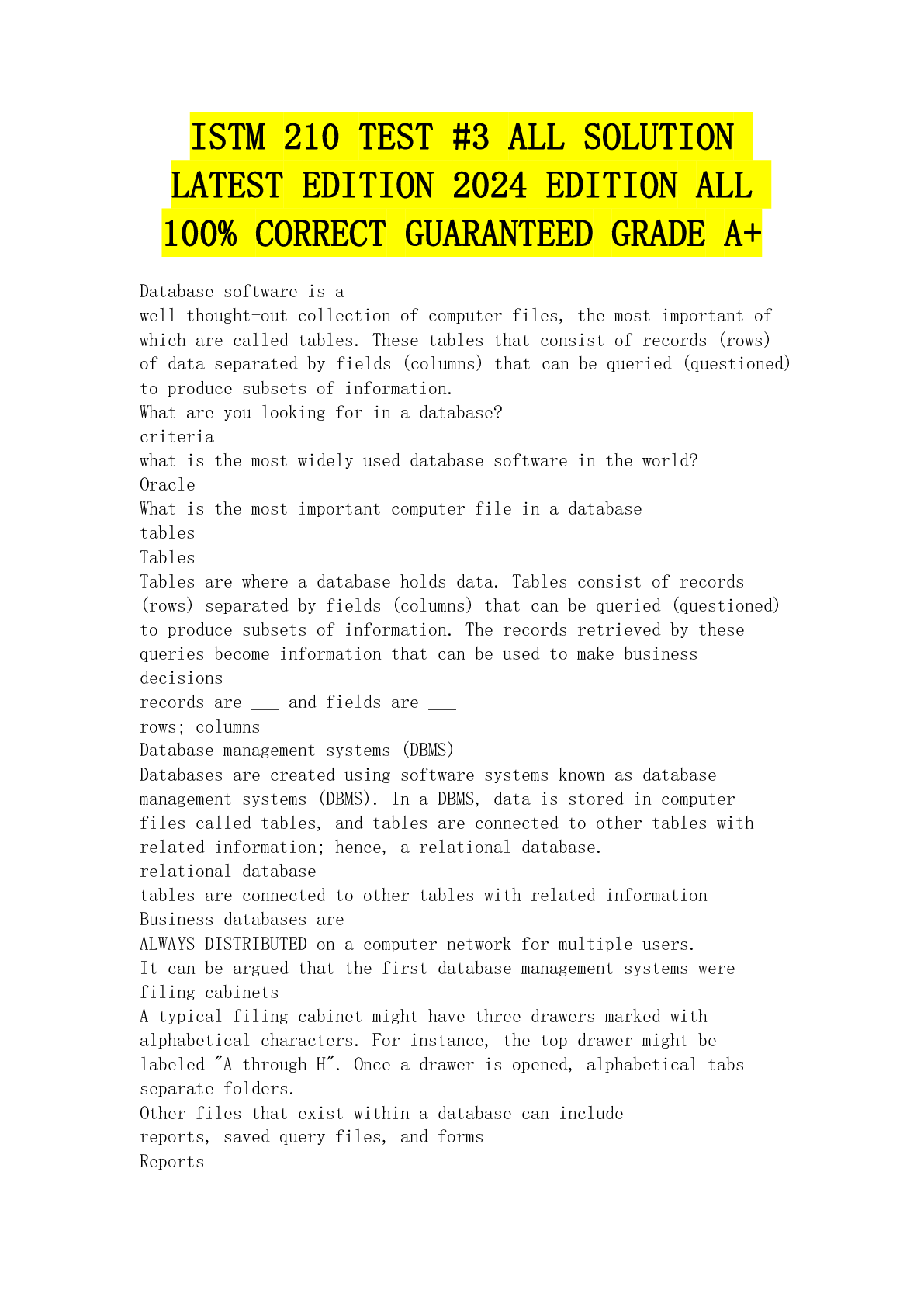
Reviews( 0 )
Document information
Connected school, study & course
About the document
Uploaded On
Jan 16, 2024
Number of pages
32
Written in
Additional information
This document has been written for:
Uploaded
Jan 16, 2024
Downloads
0
Views
29

